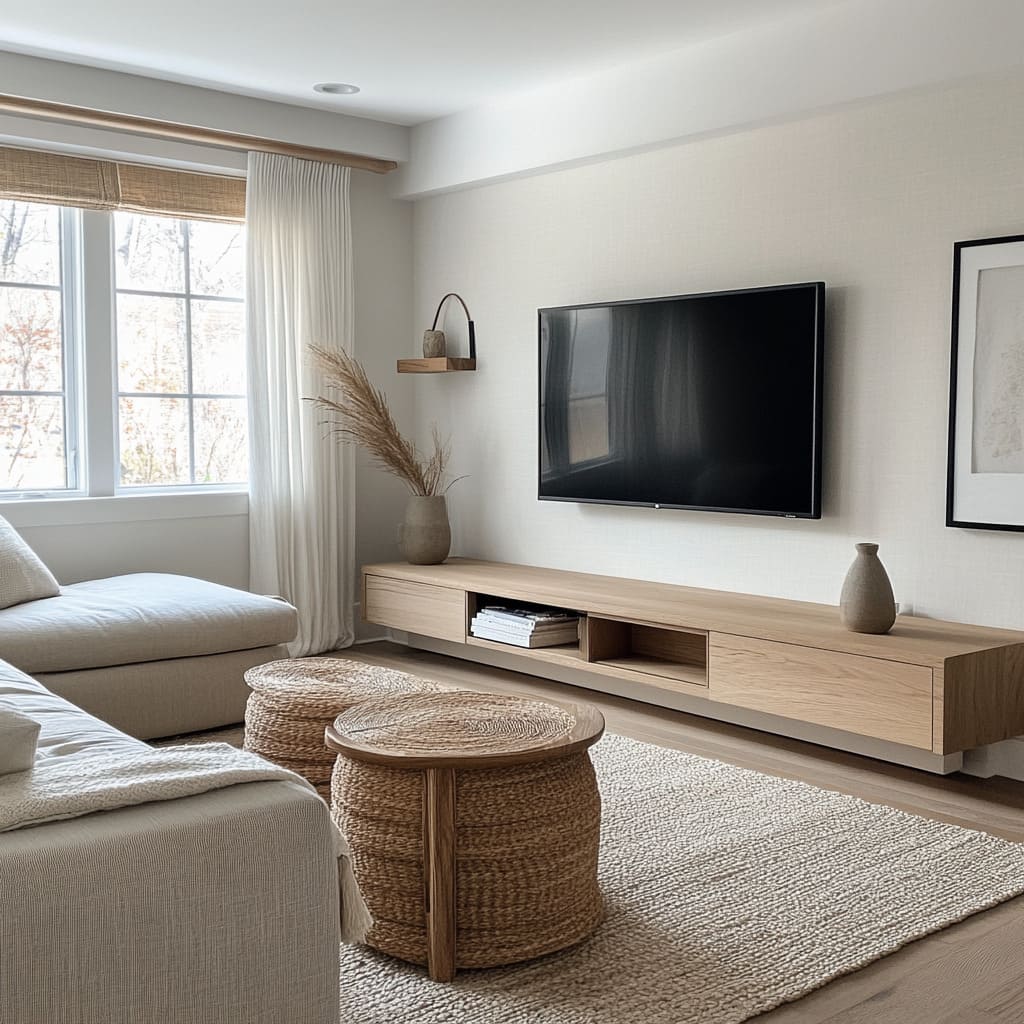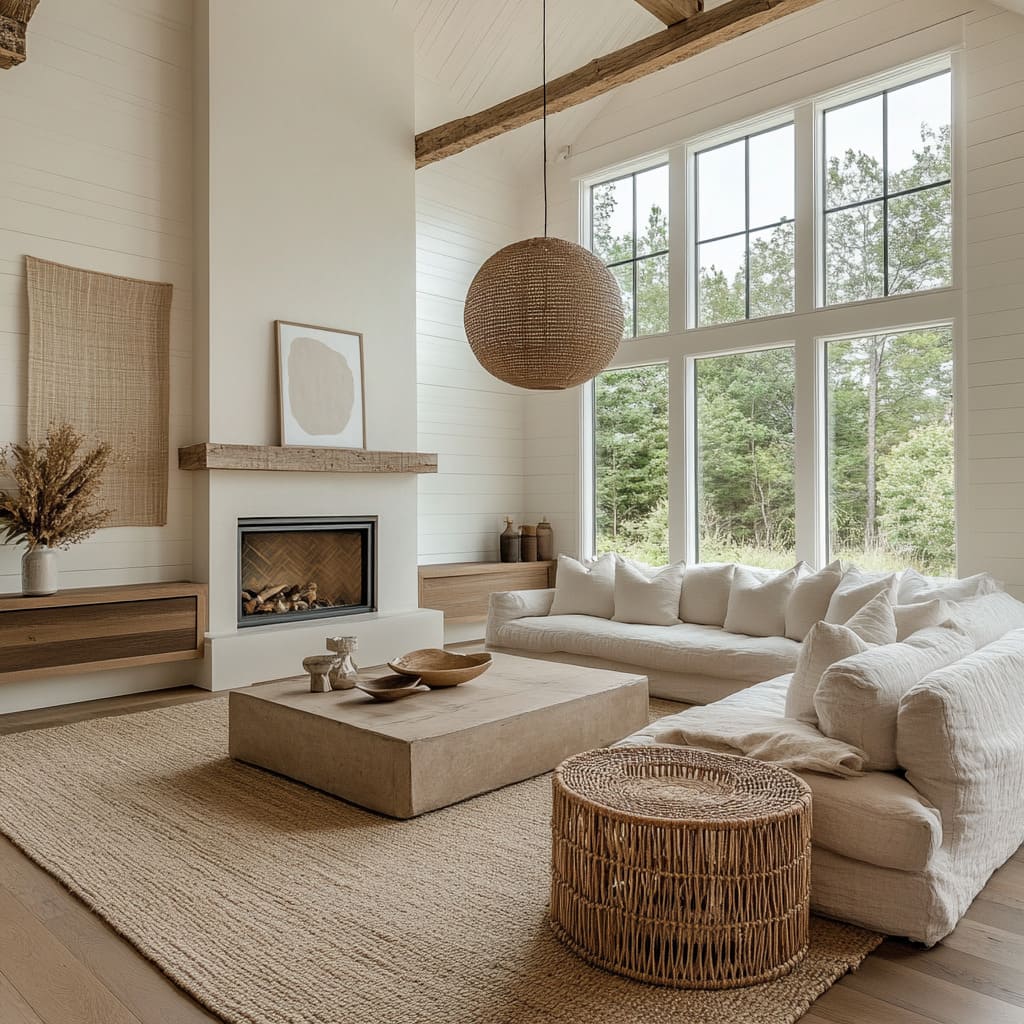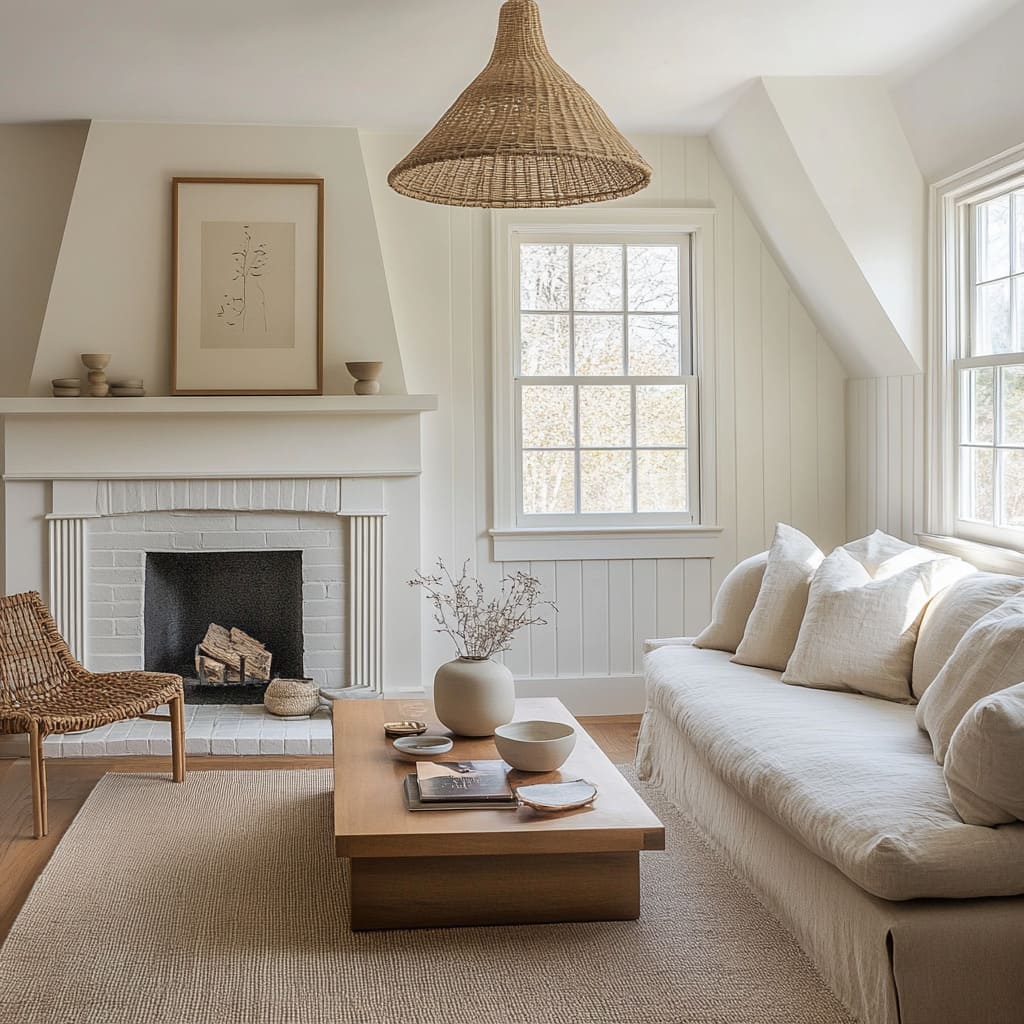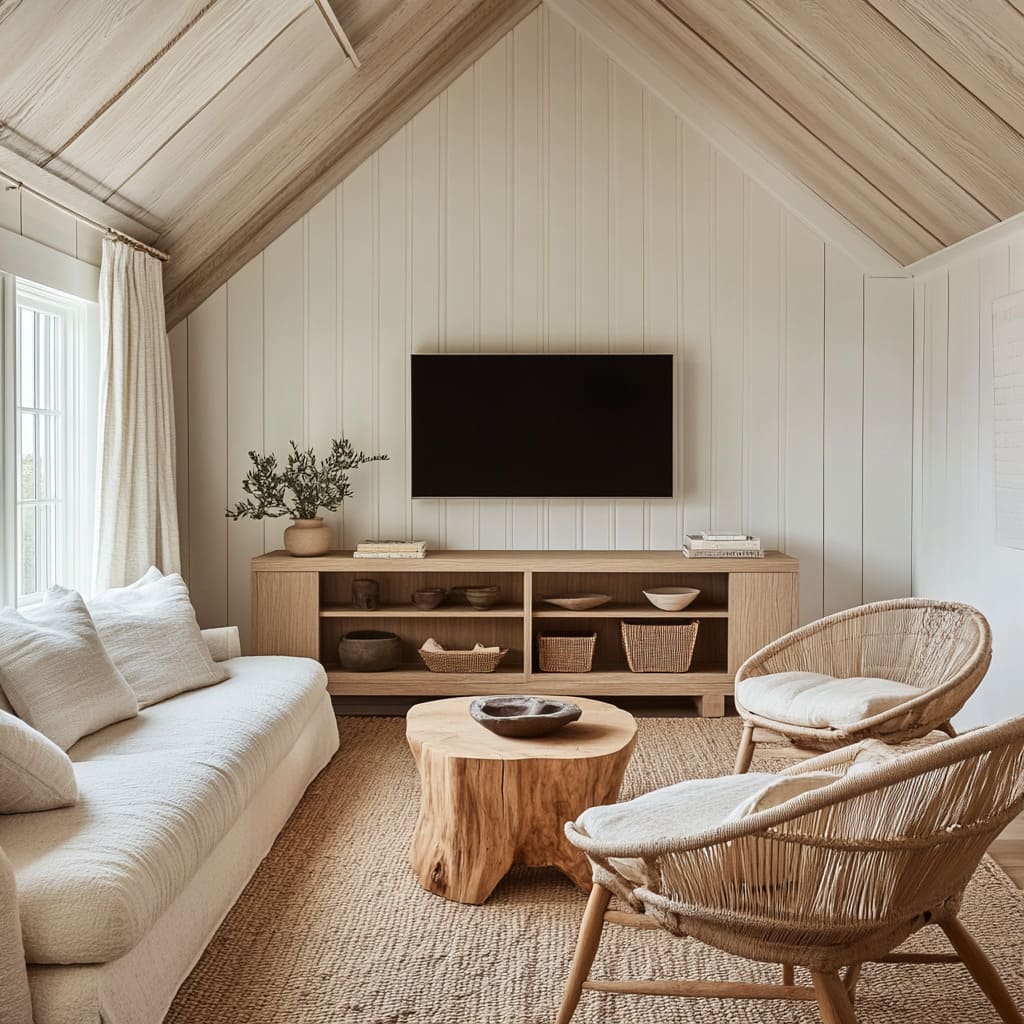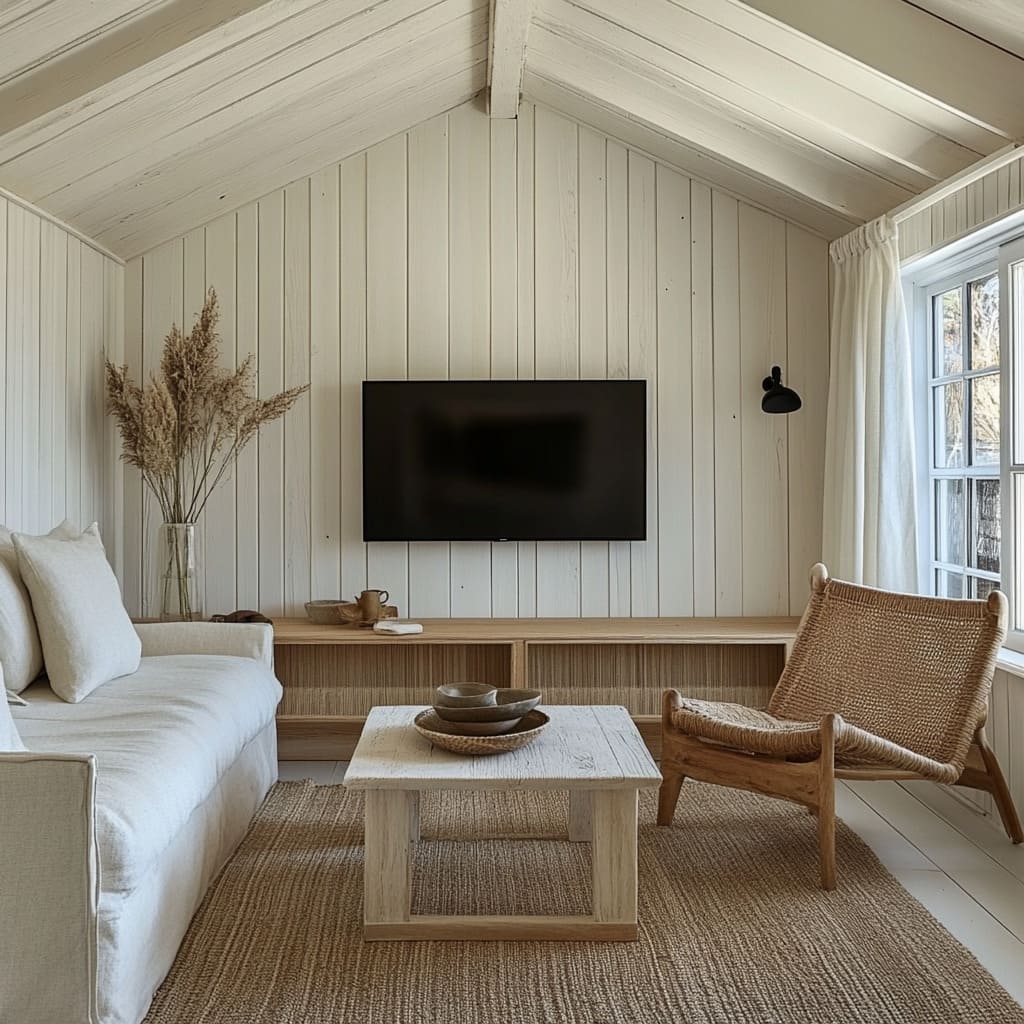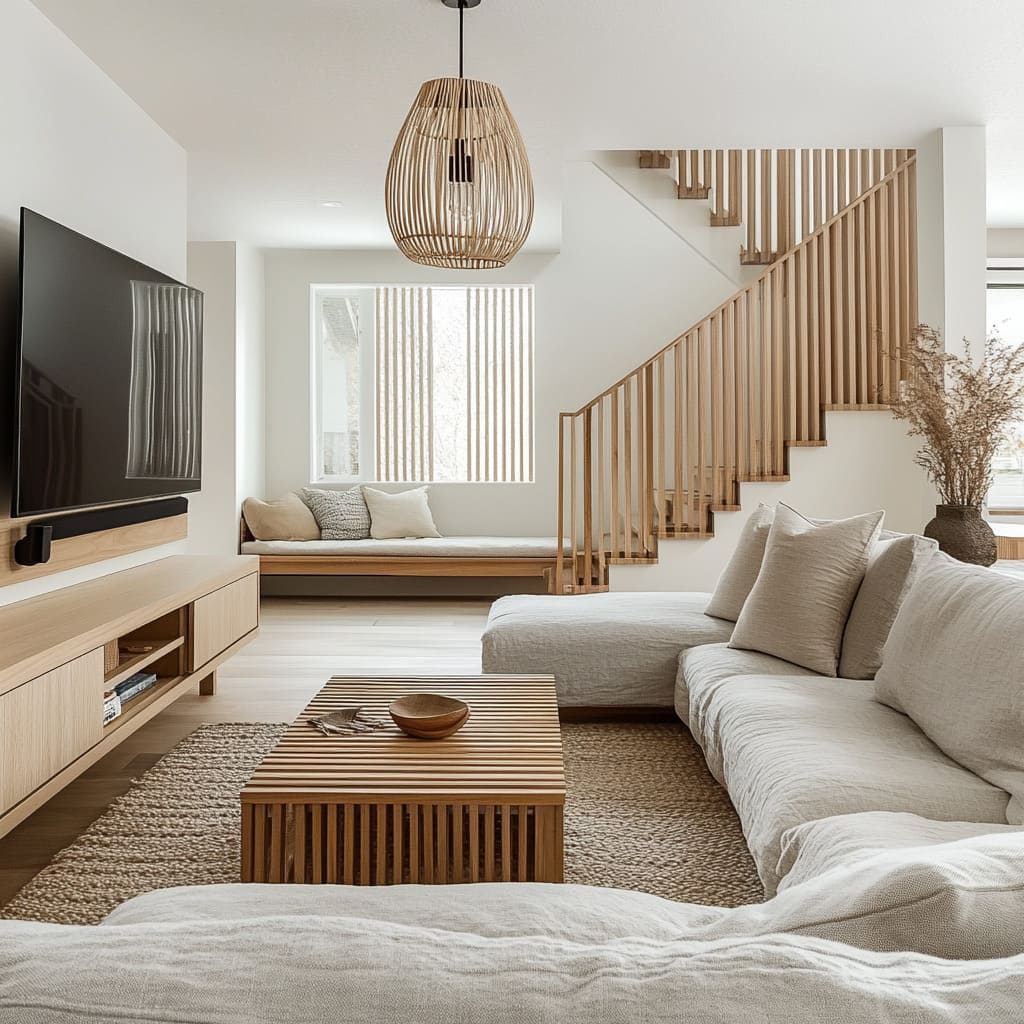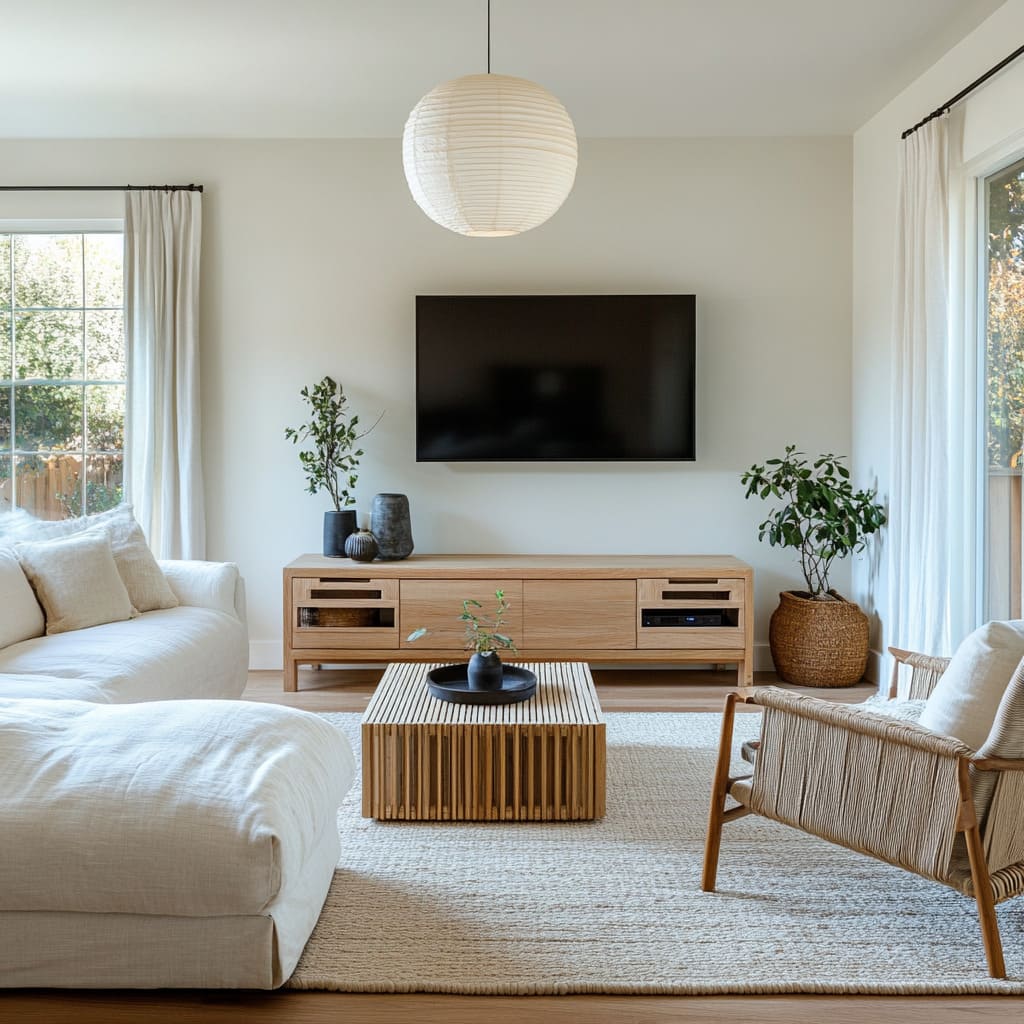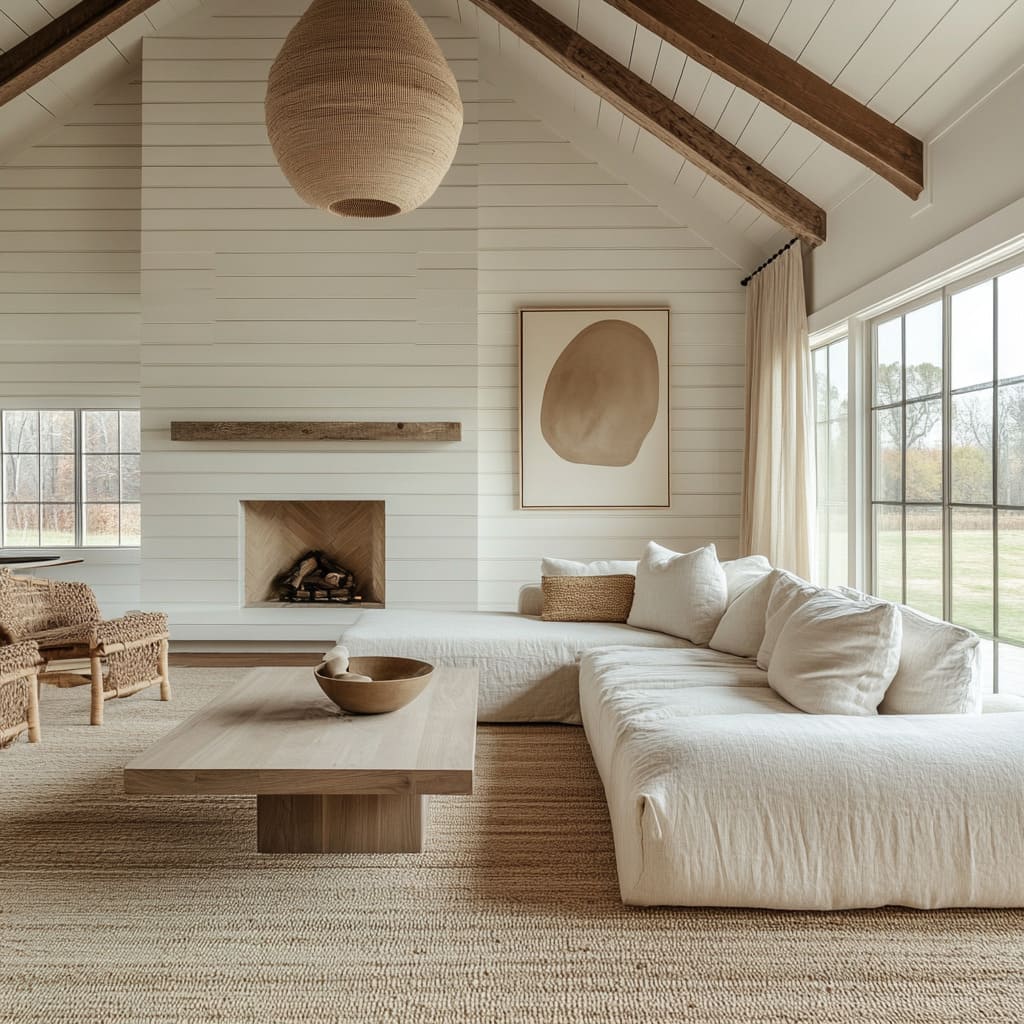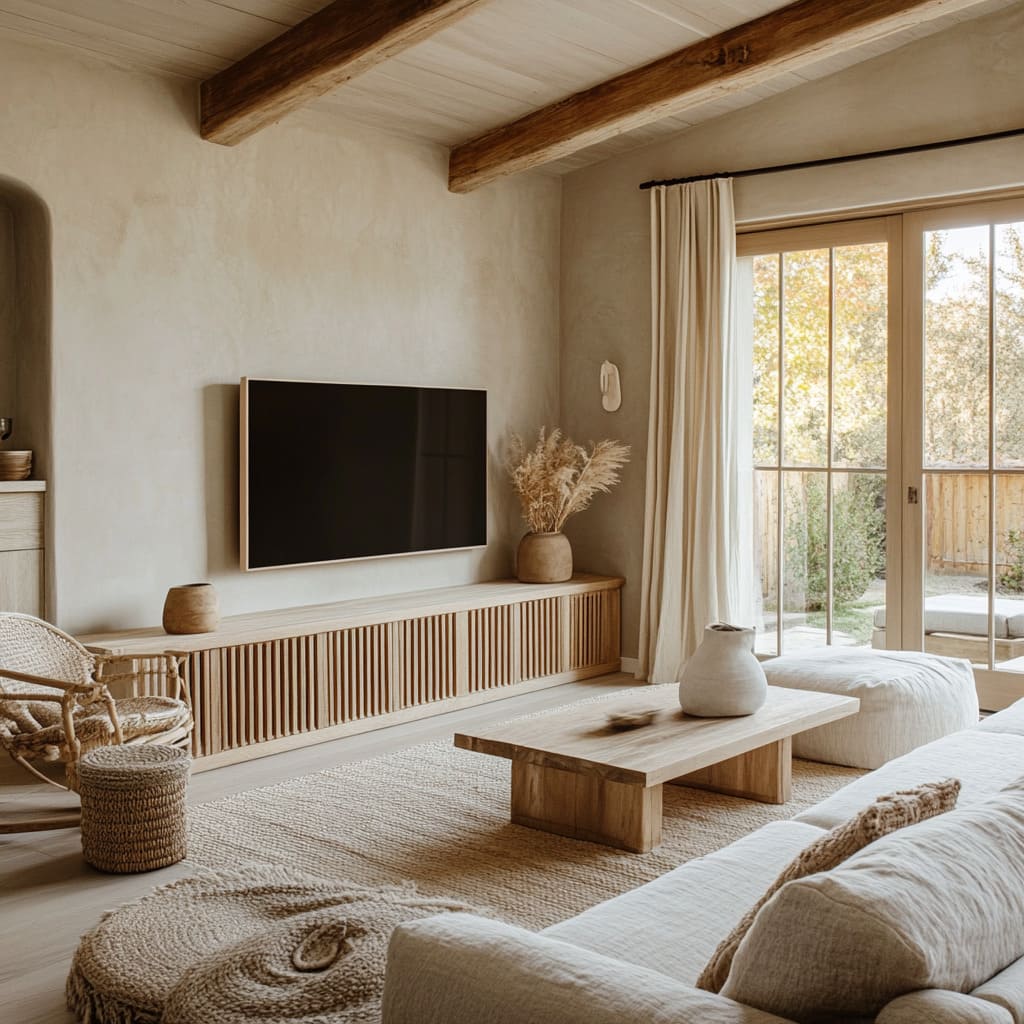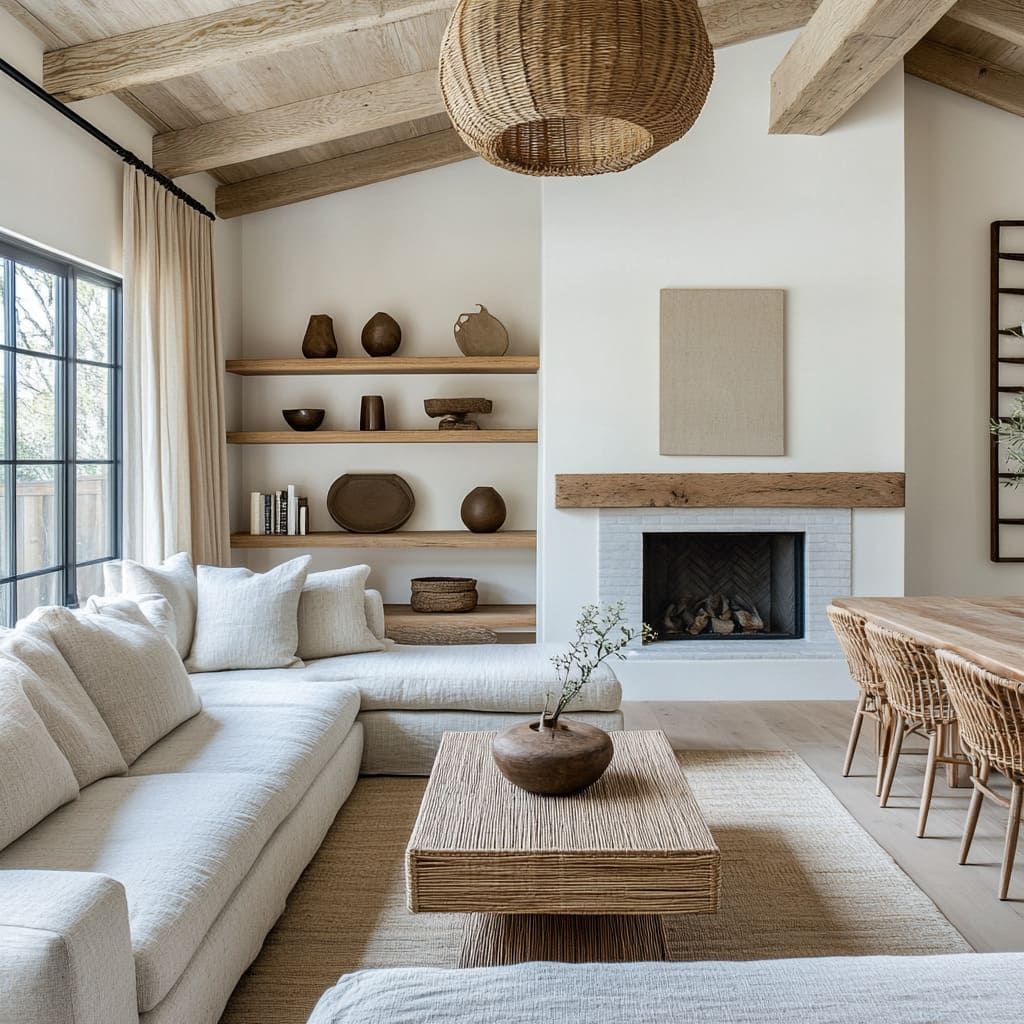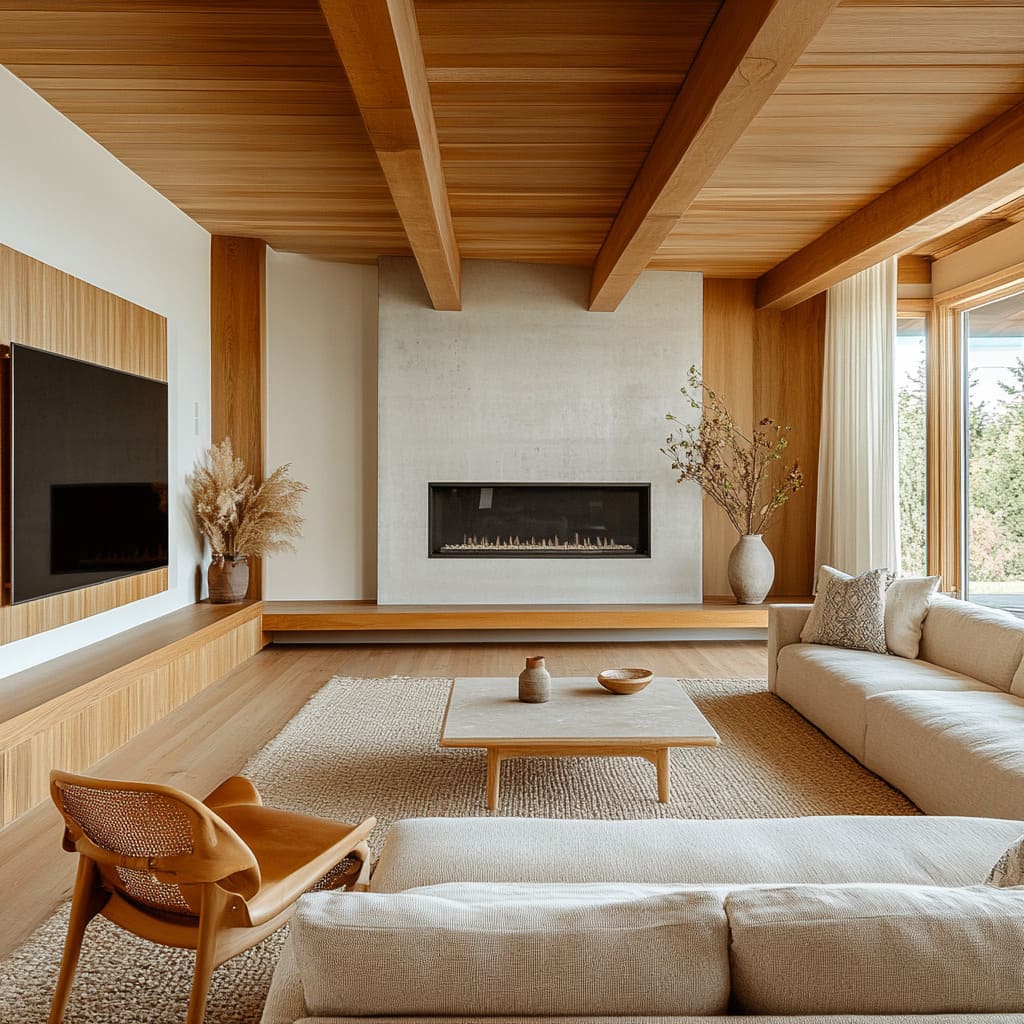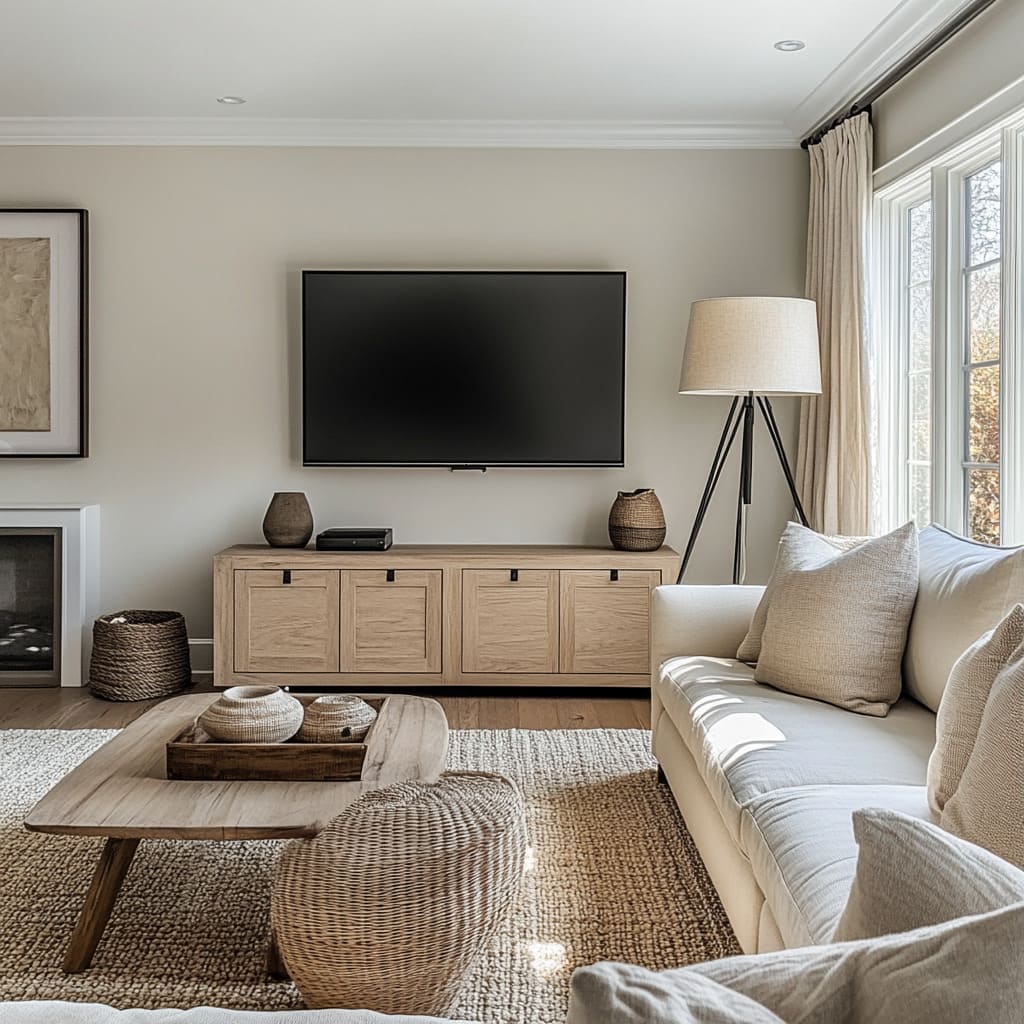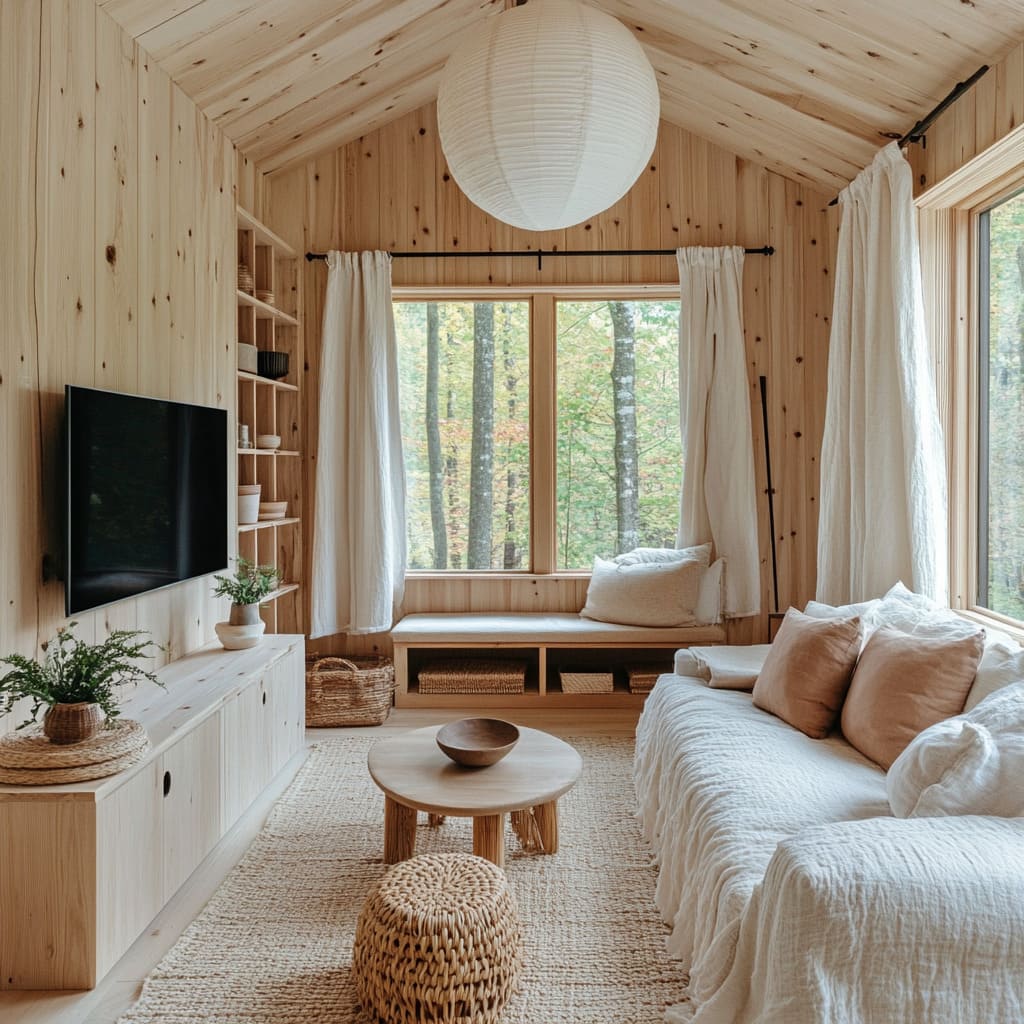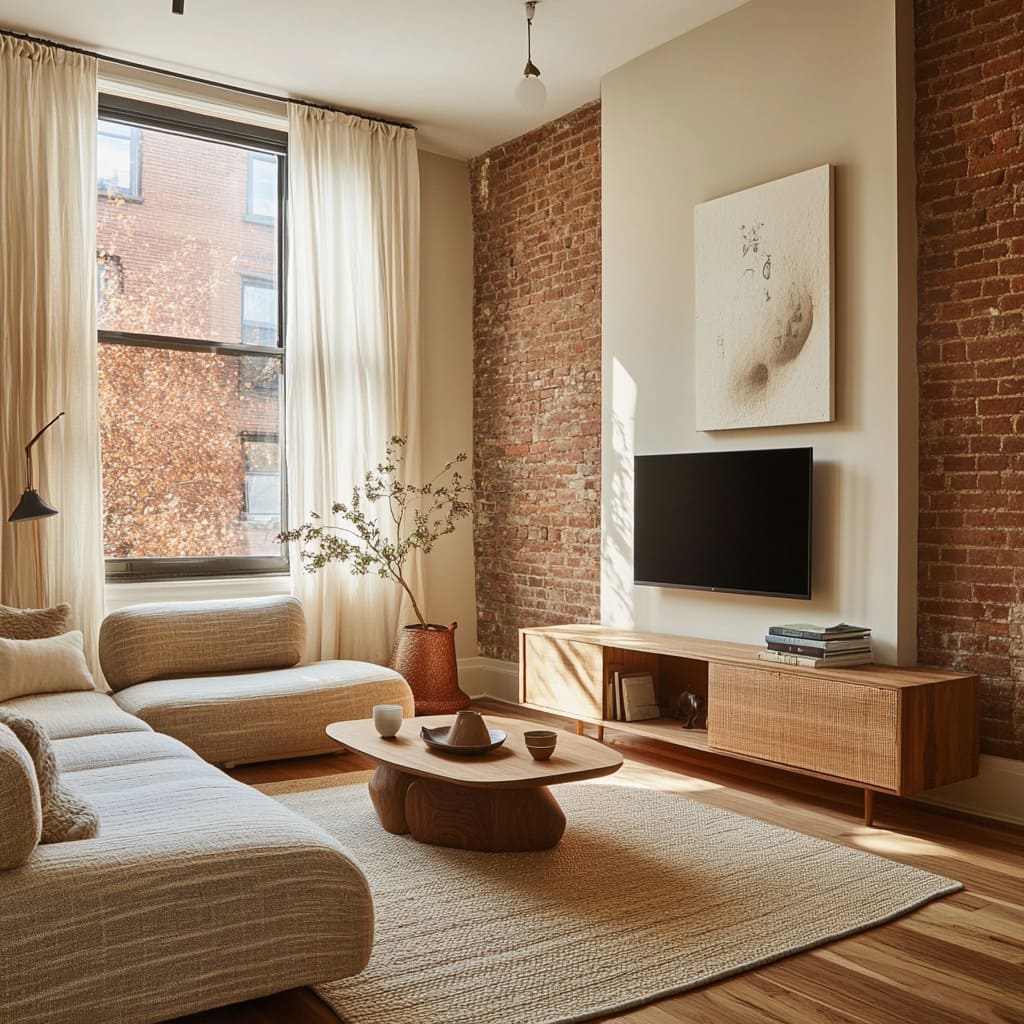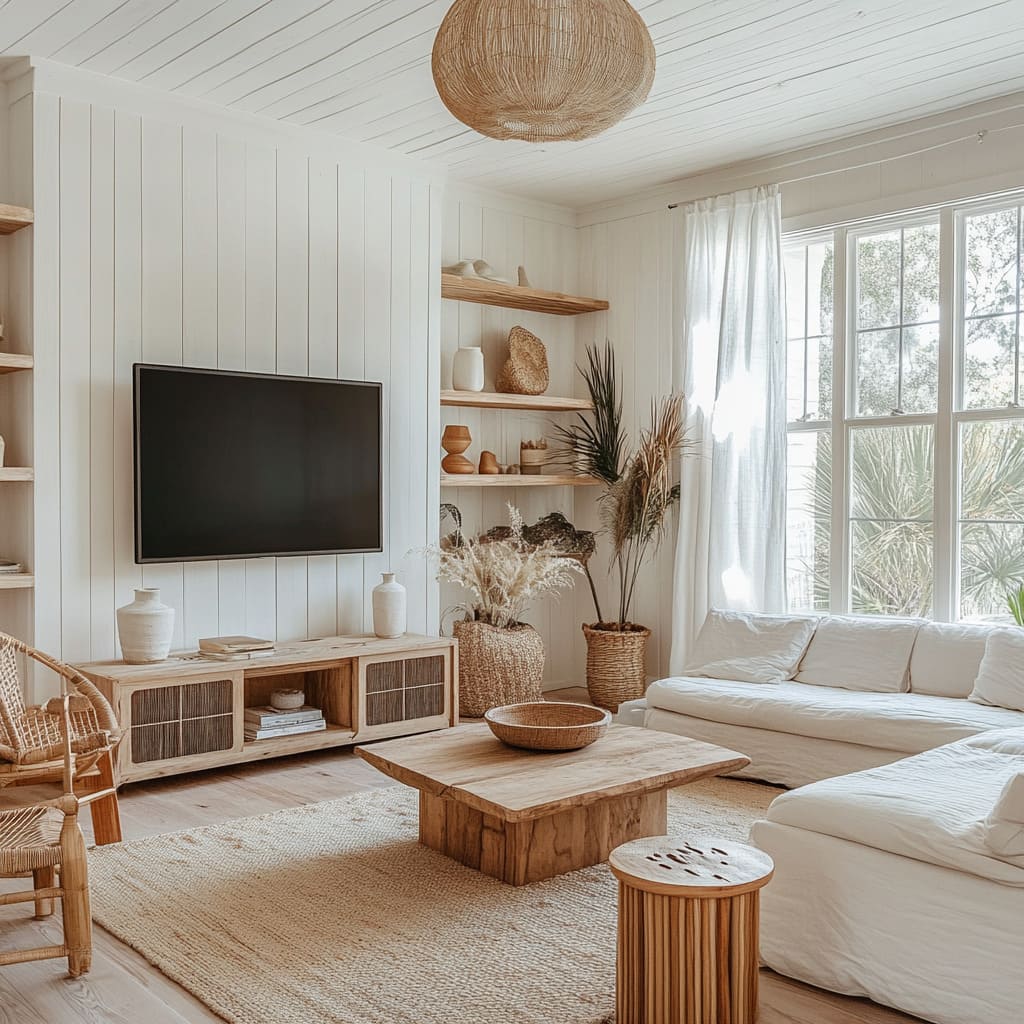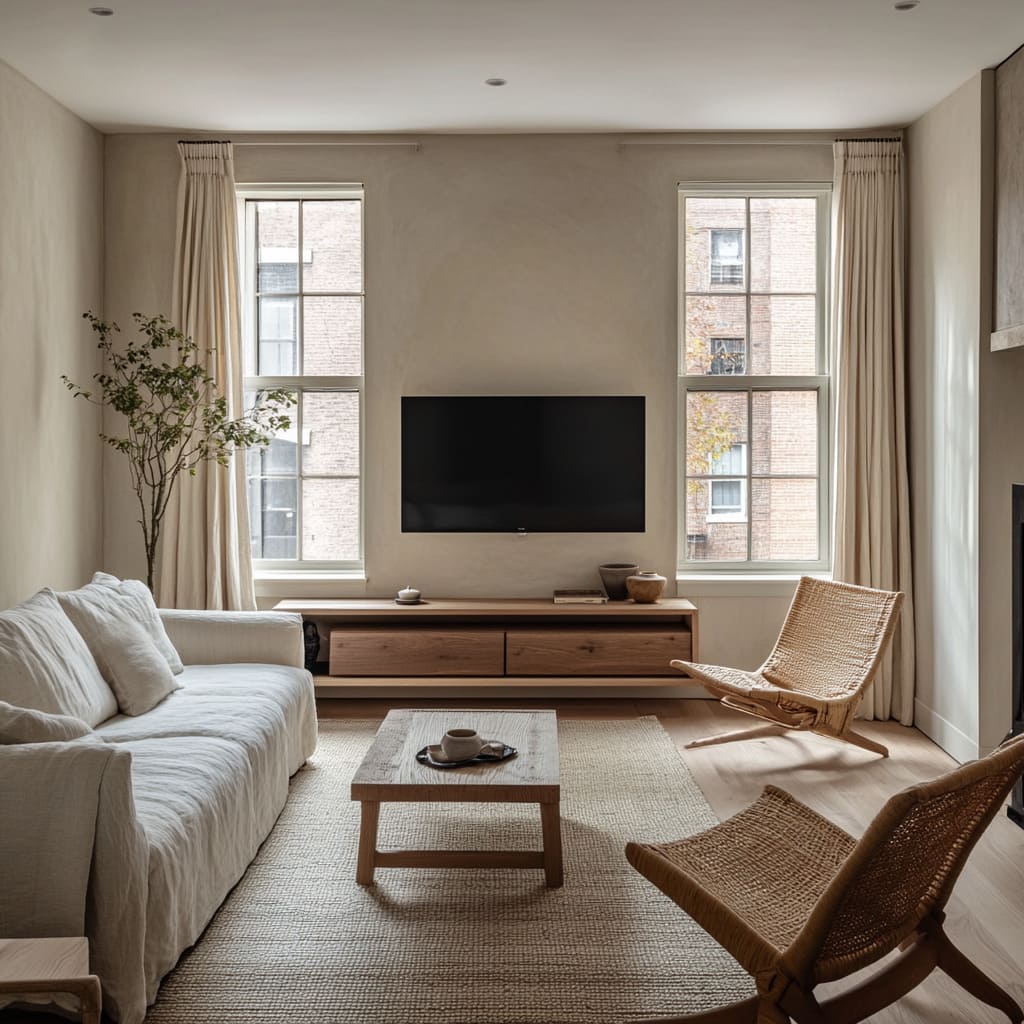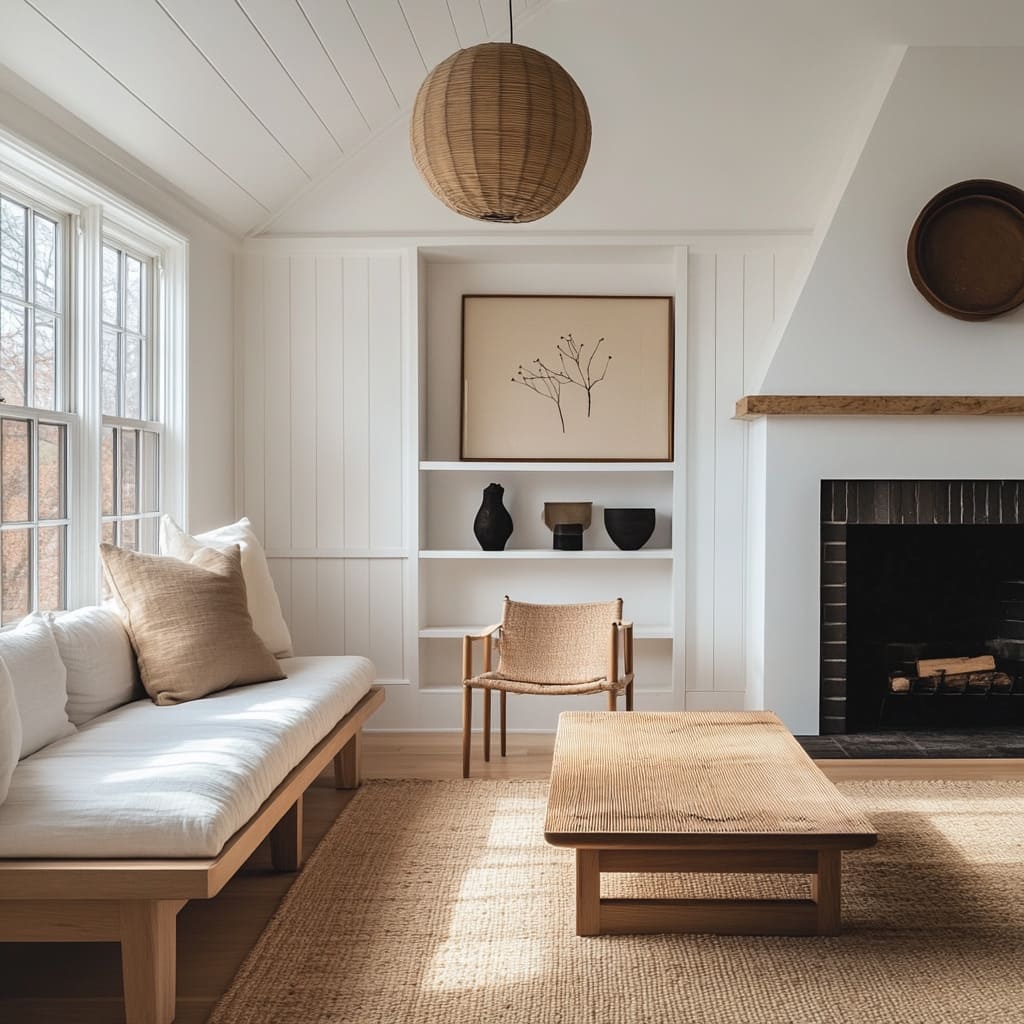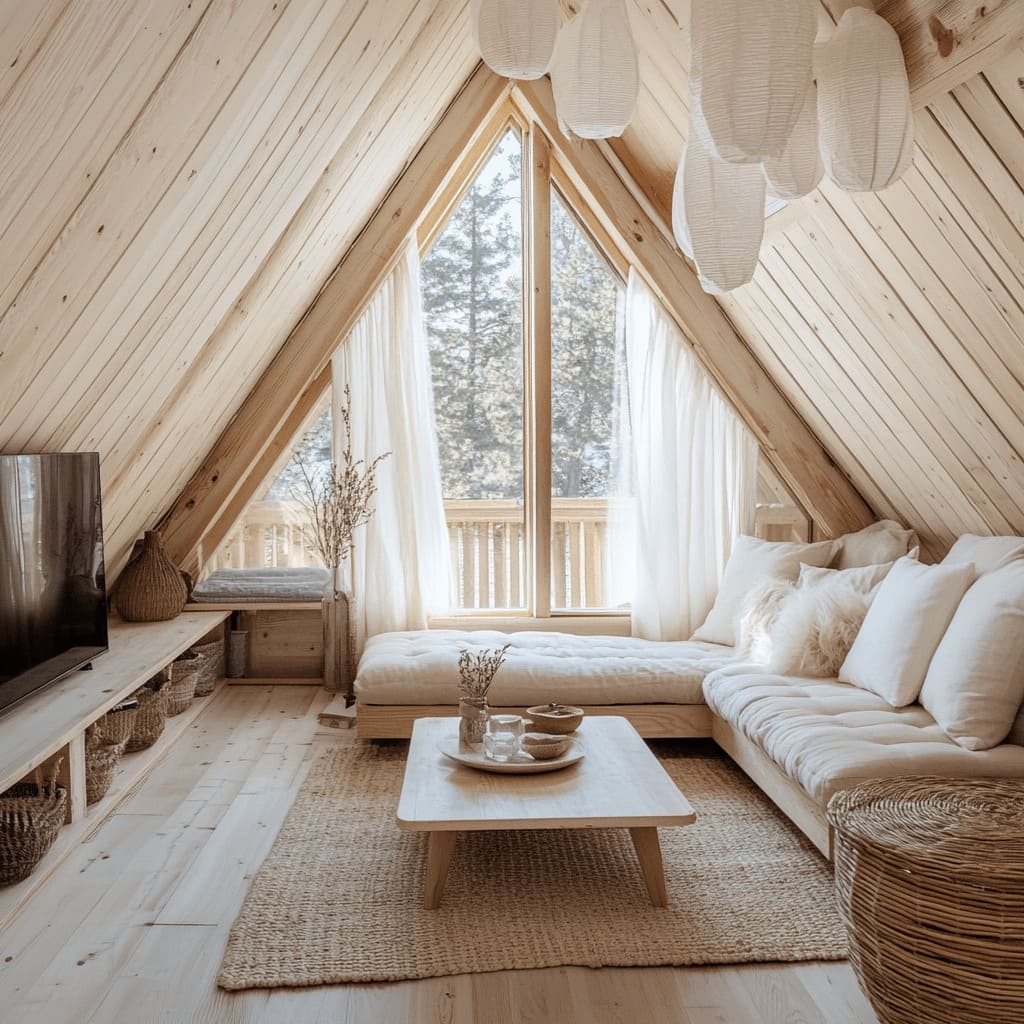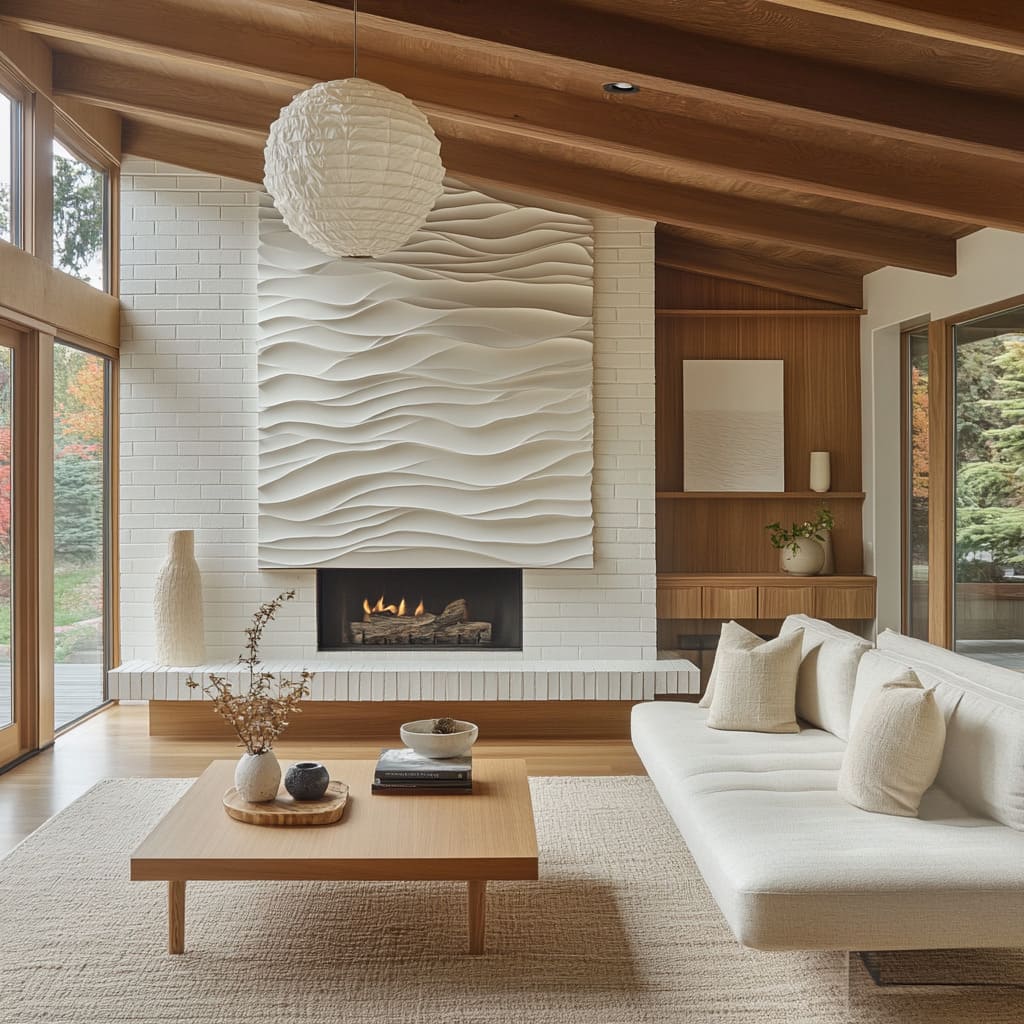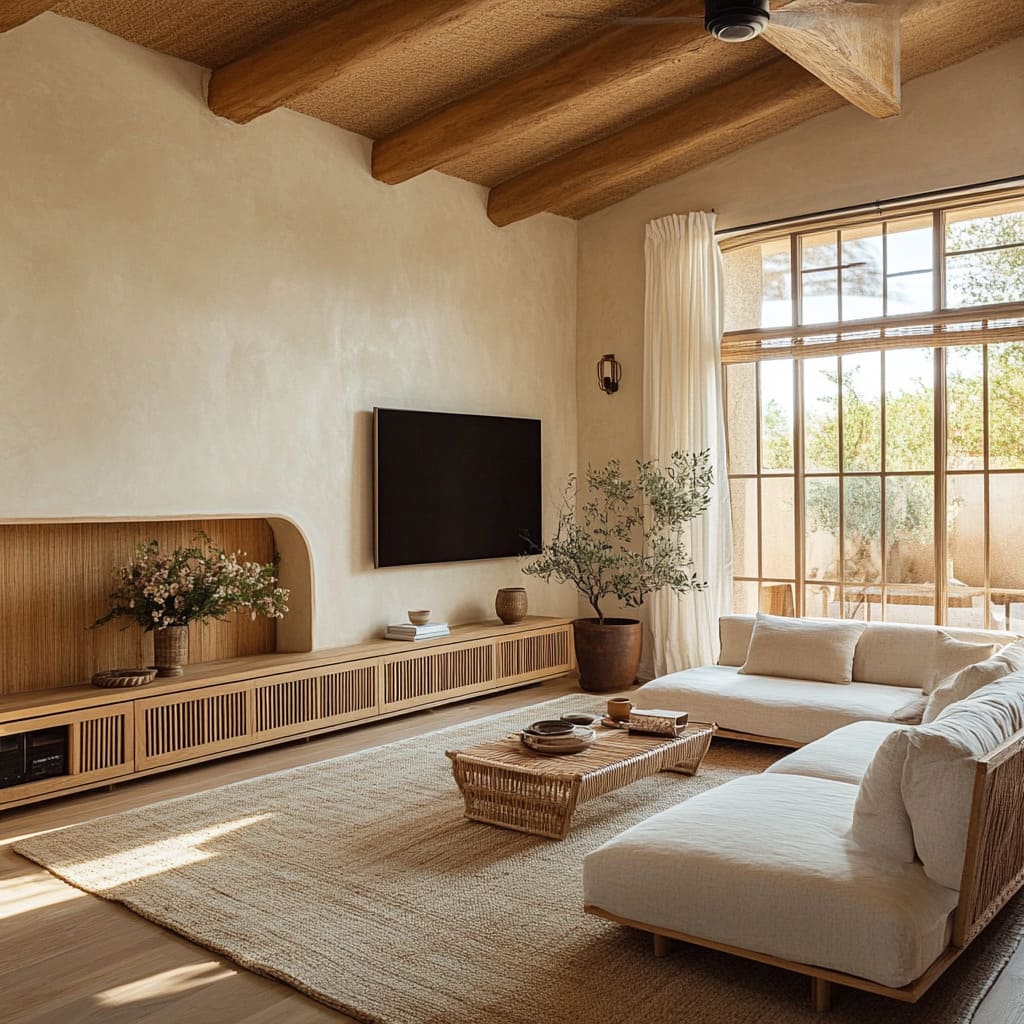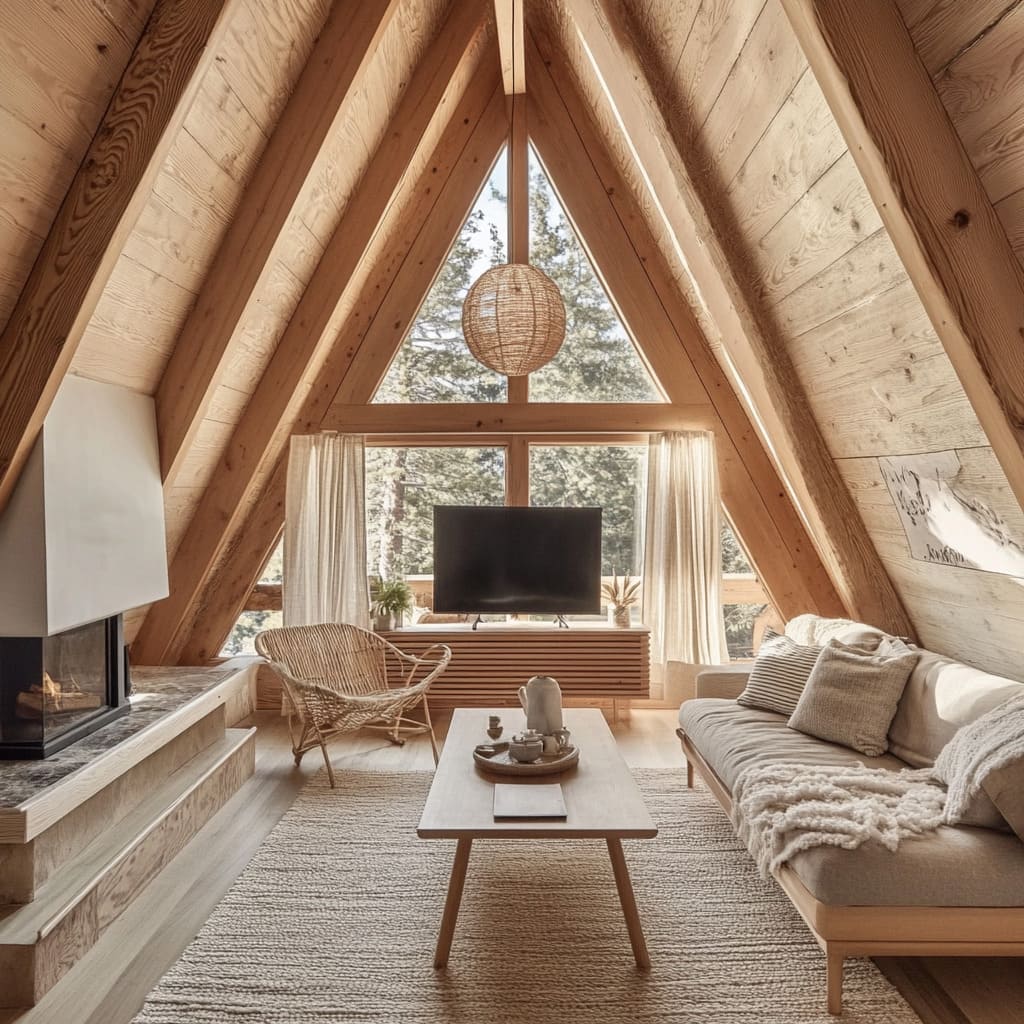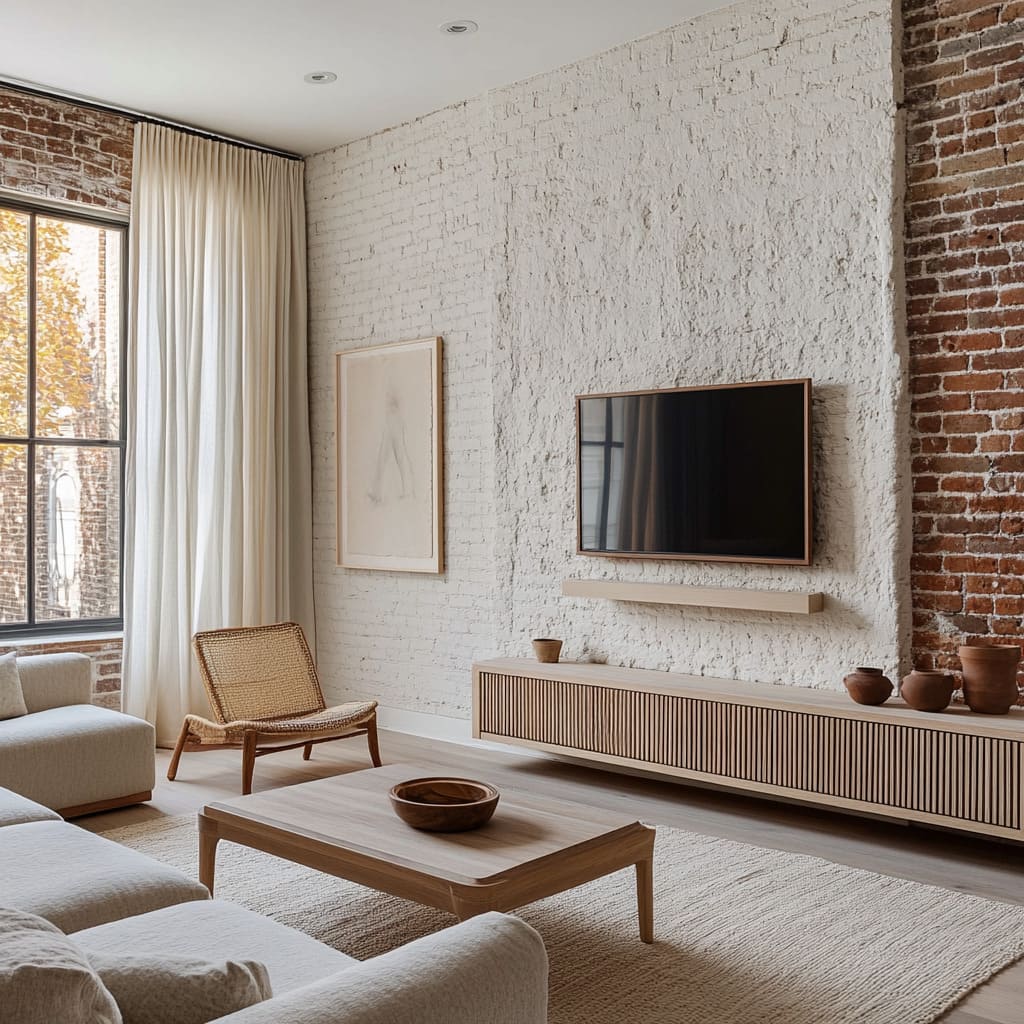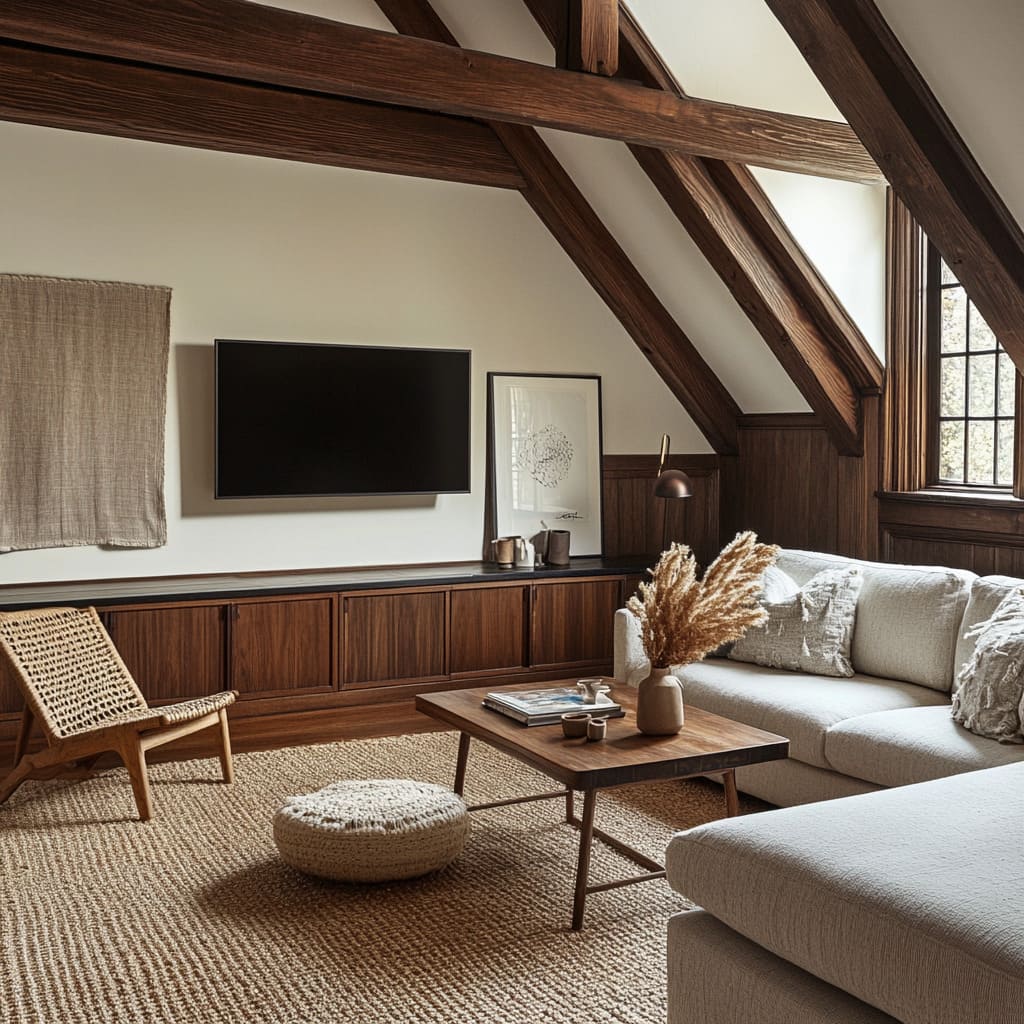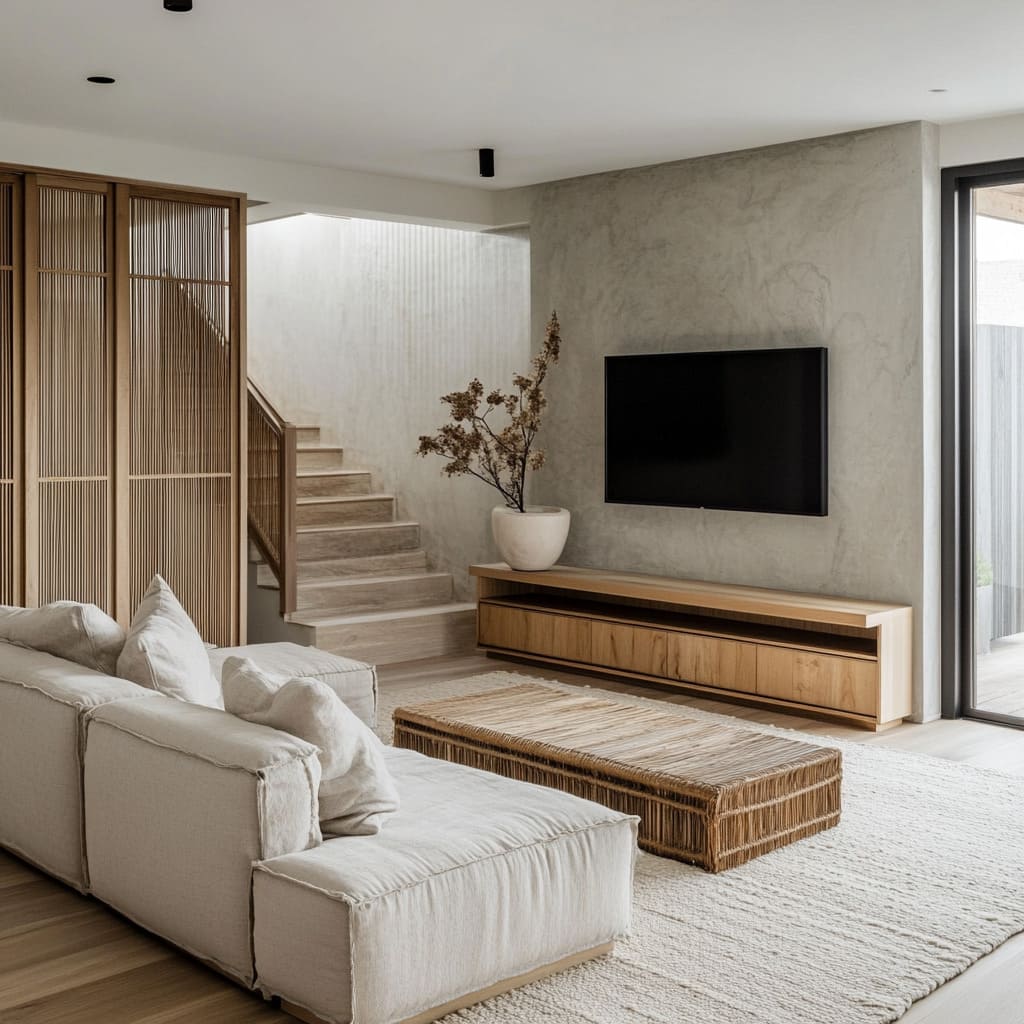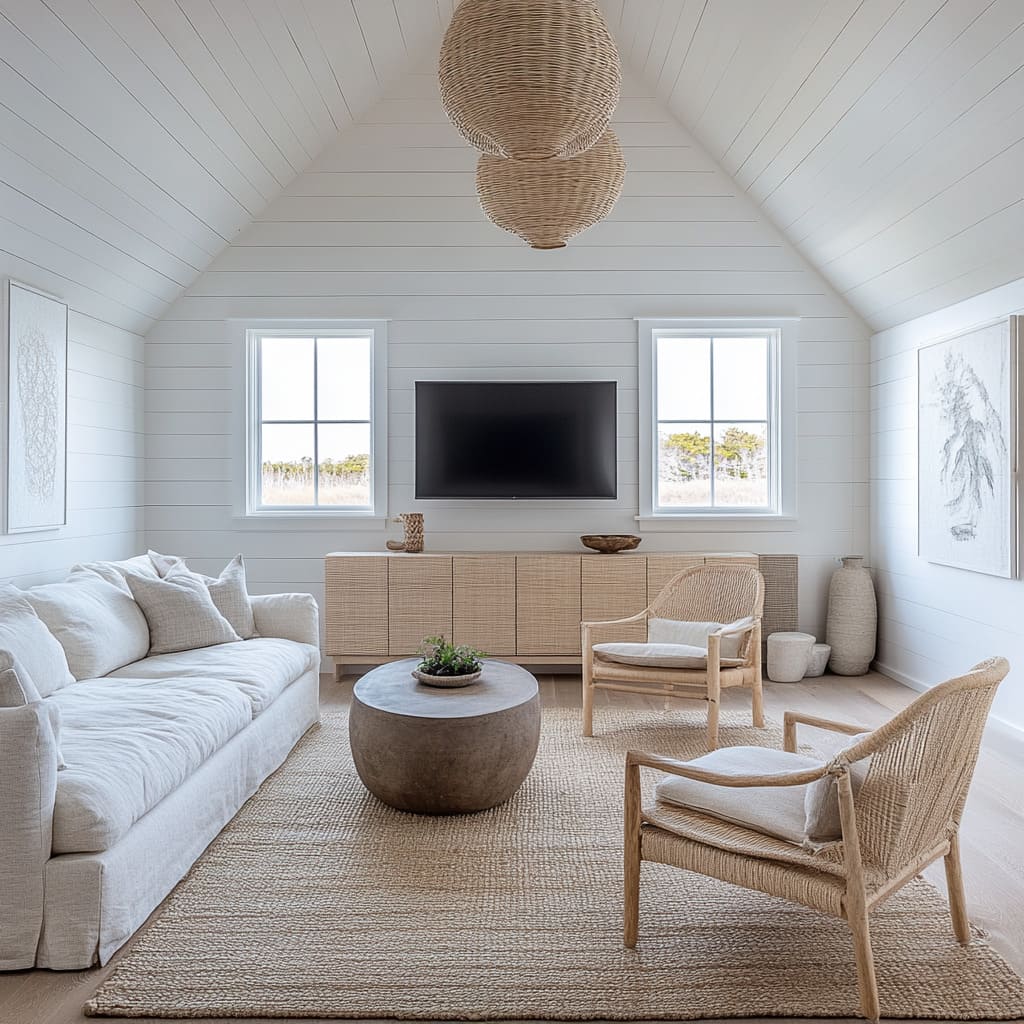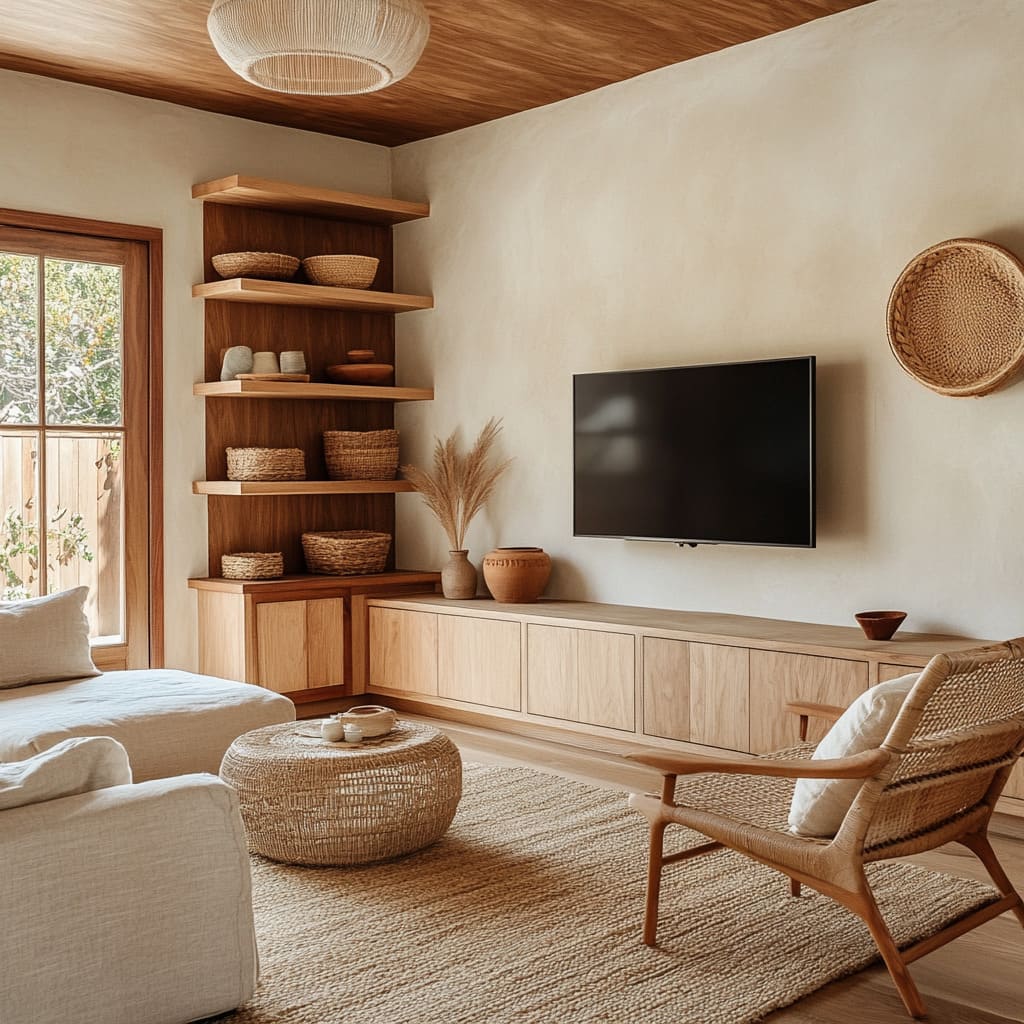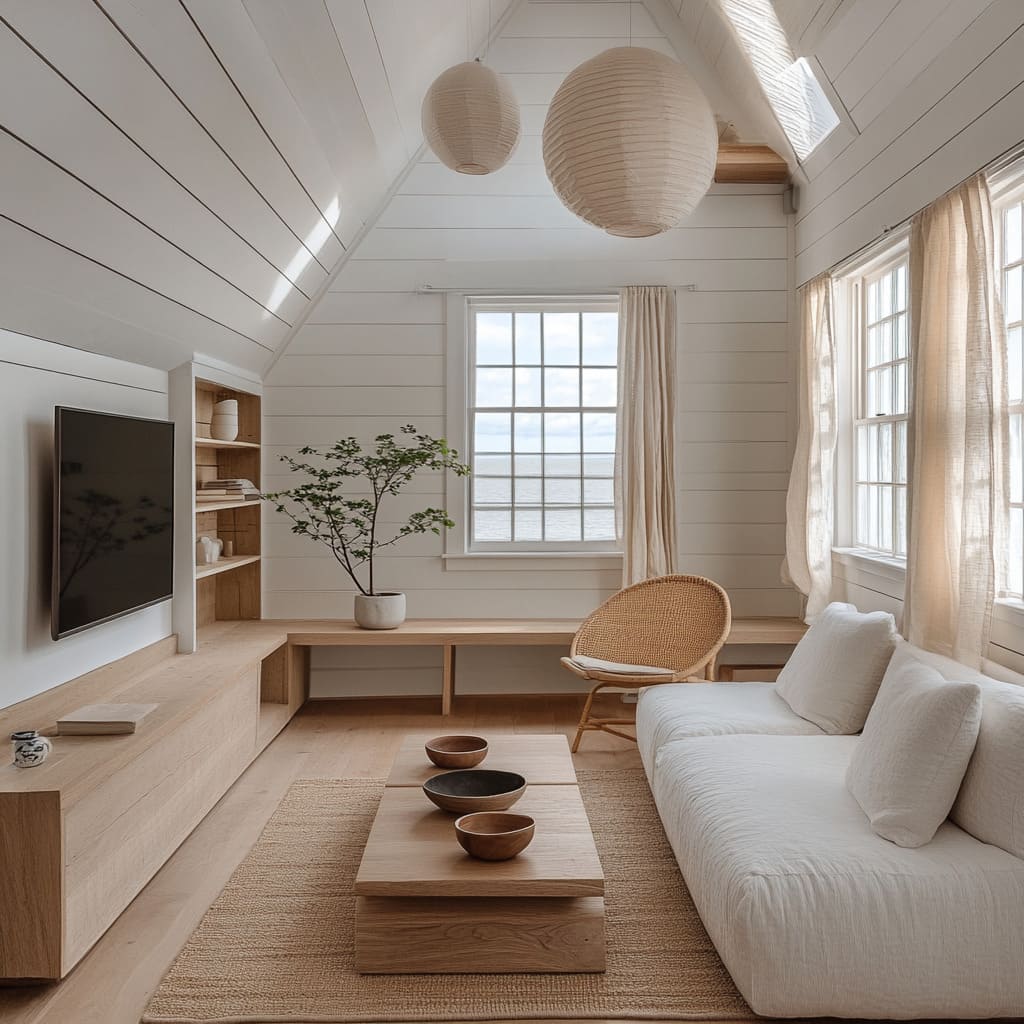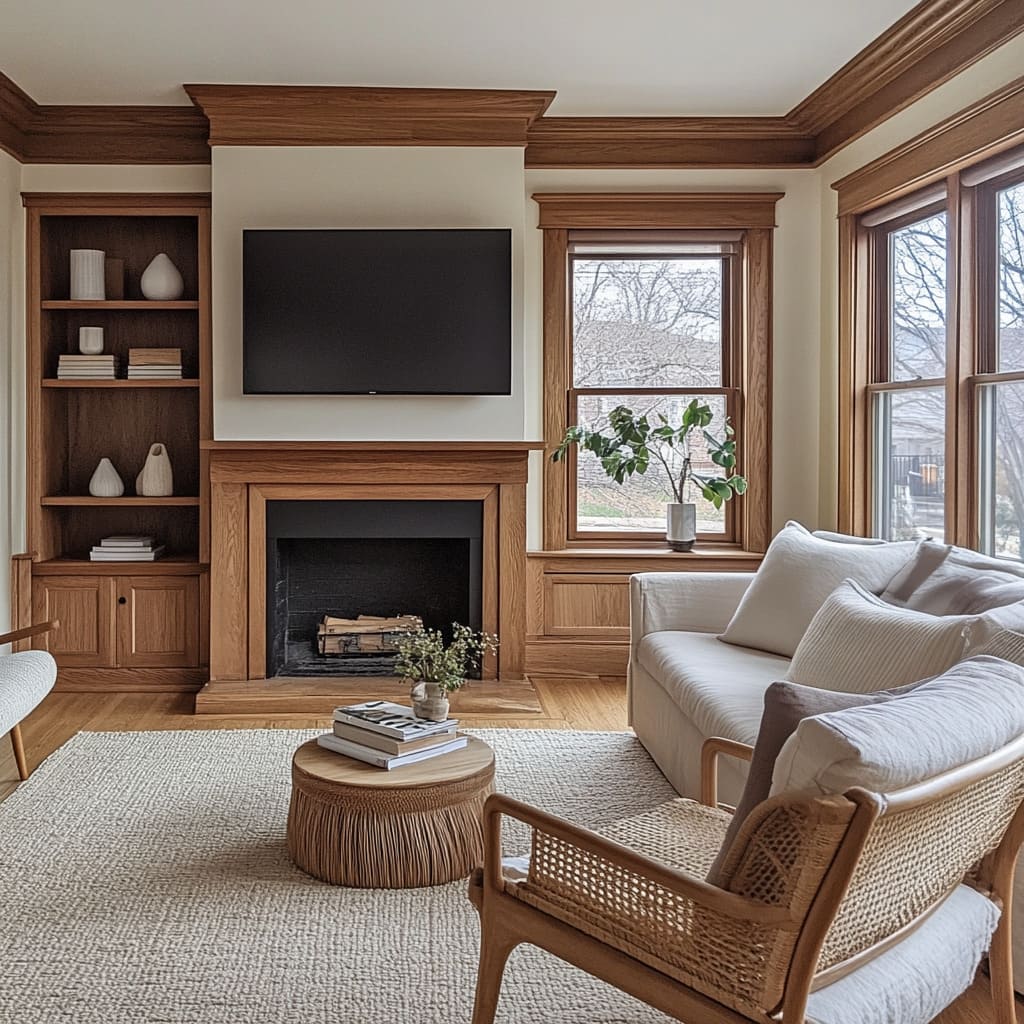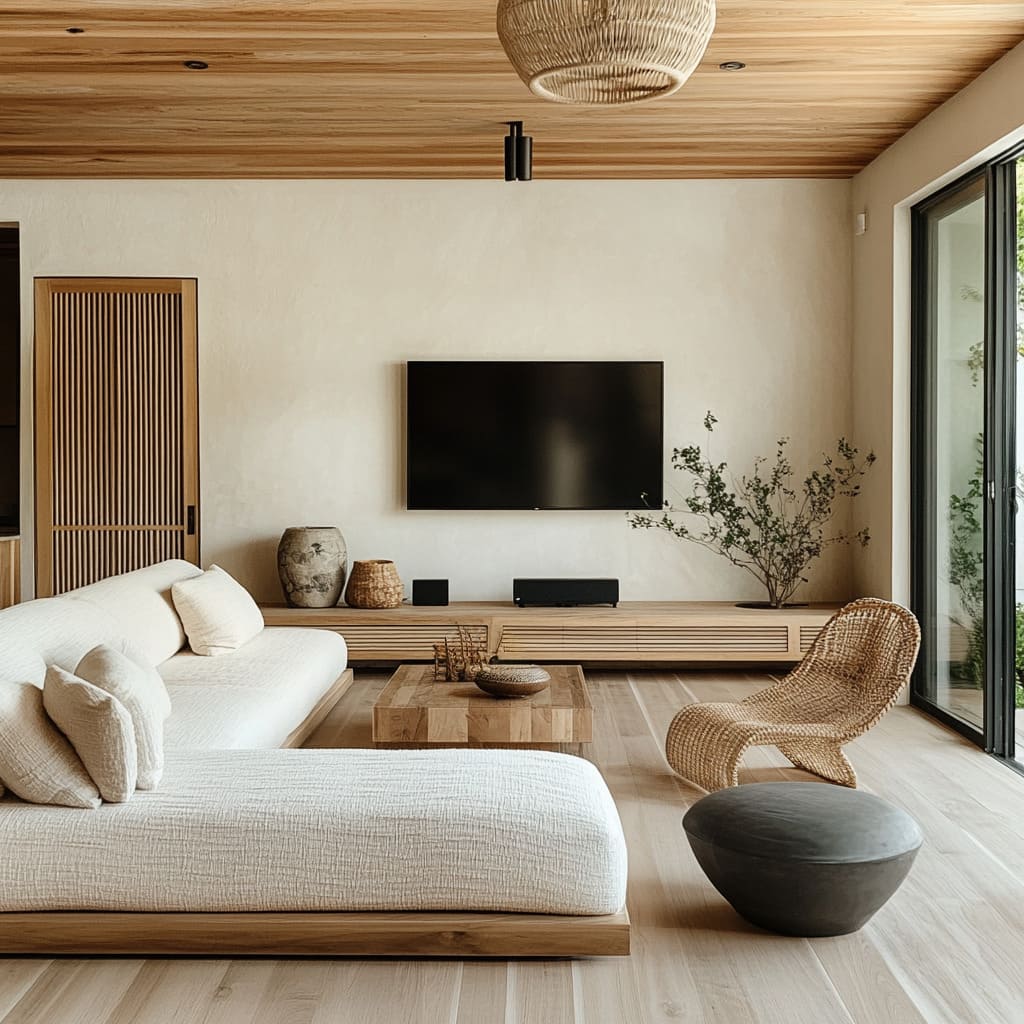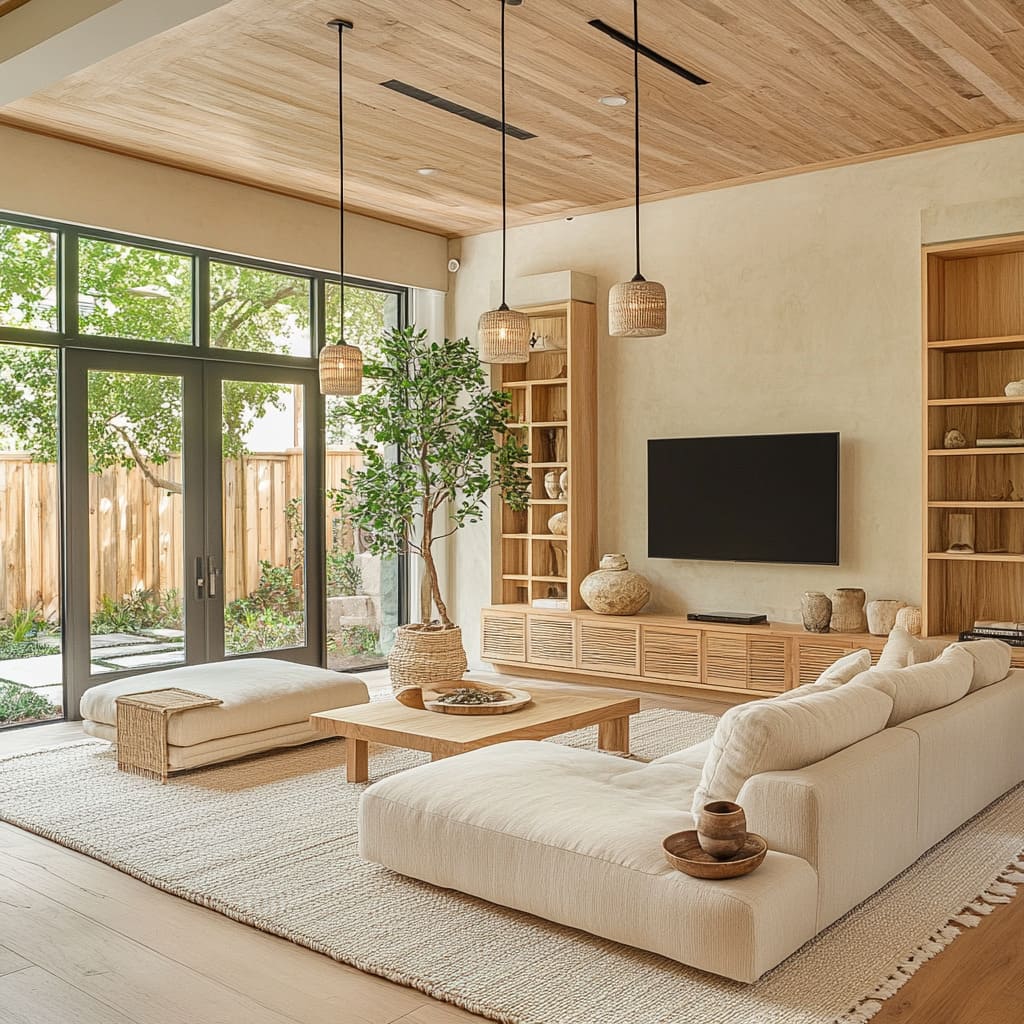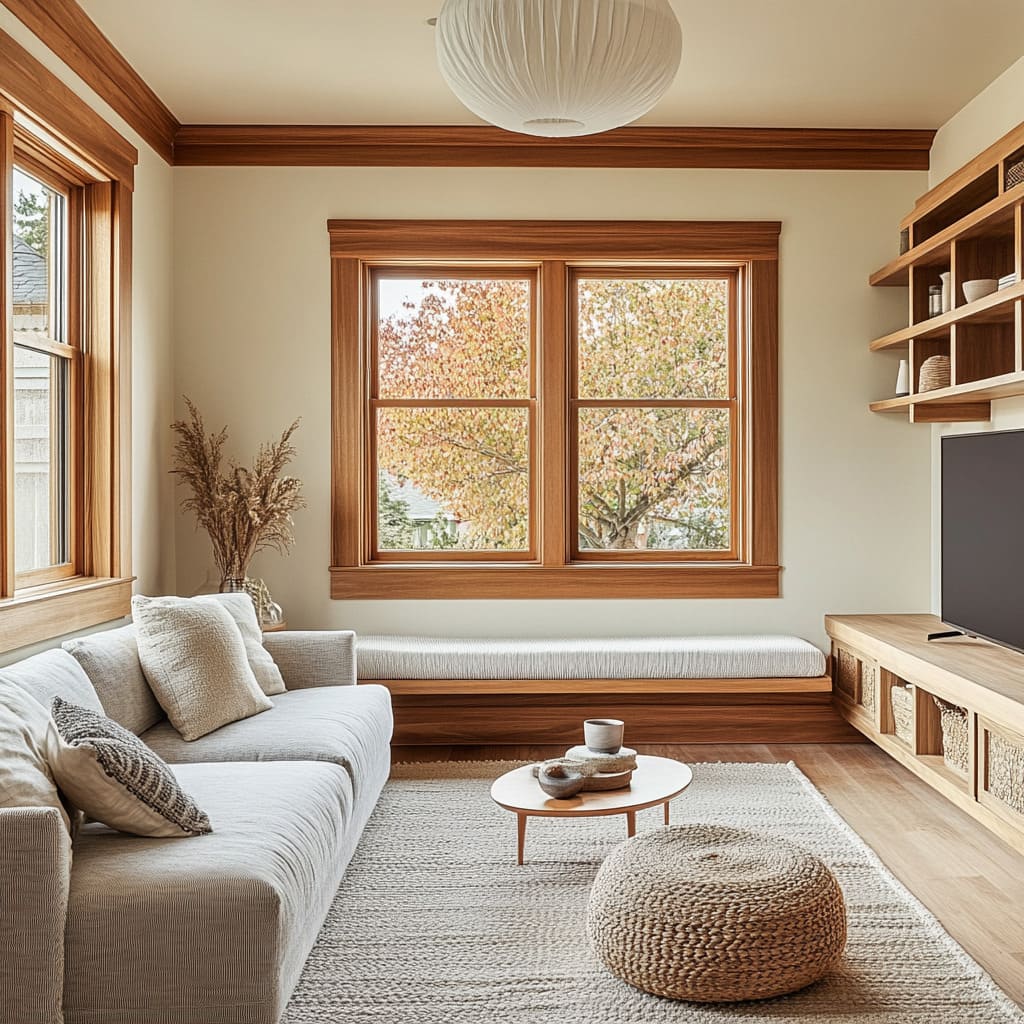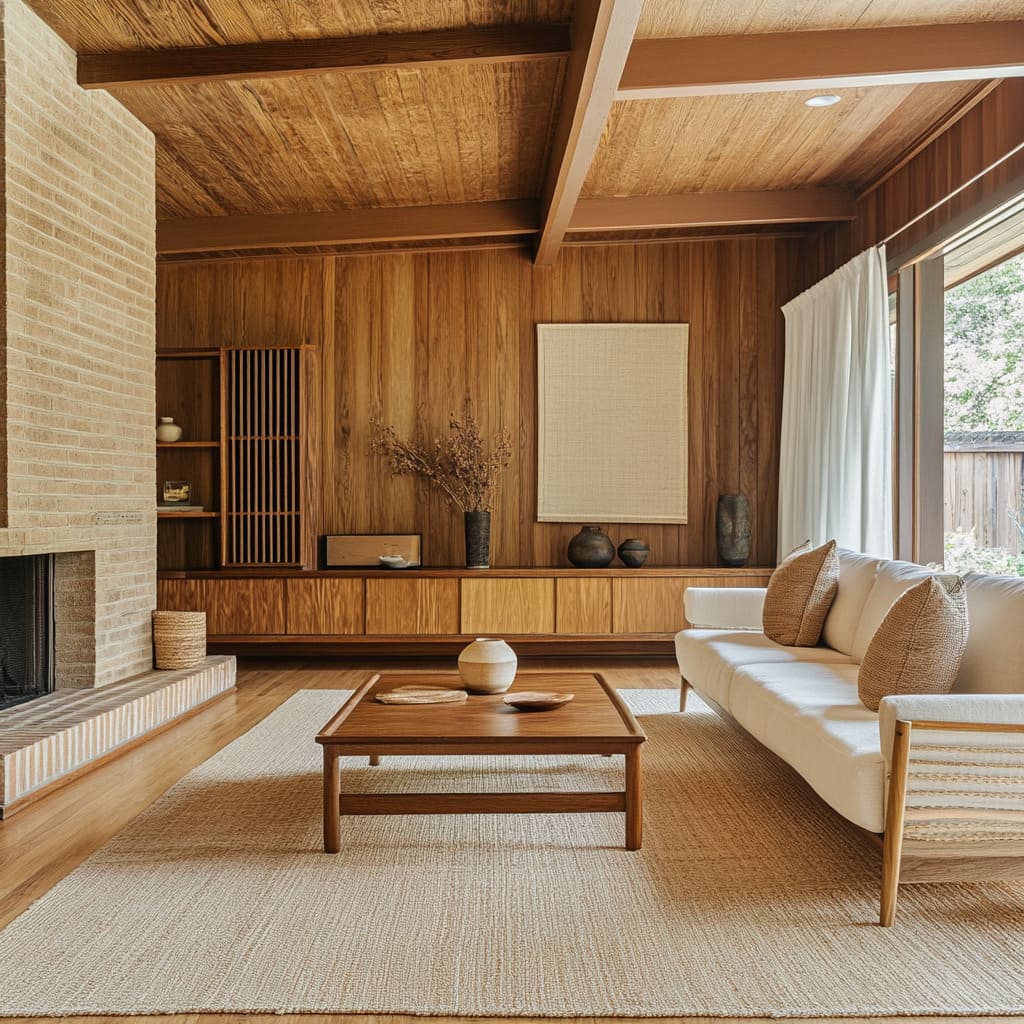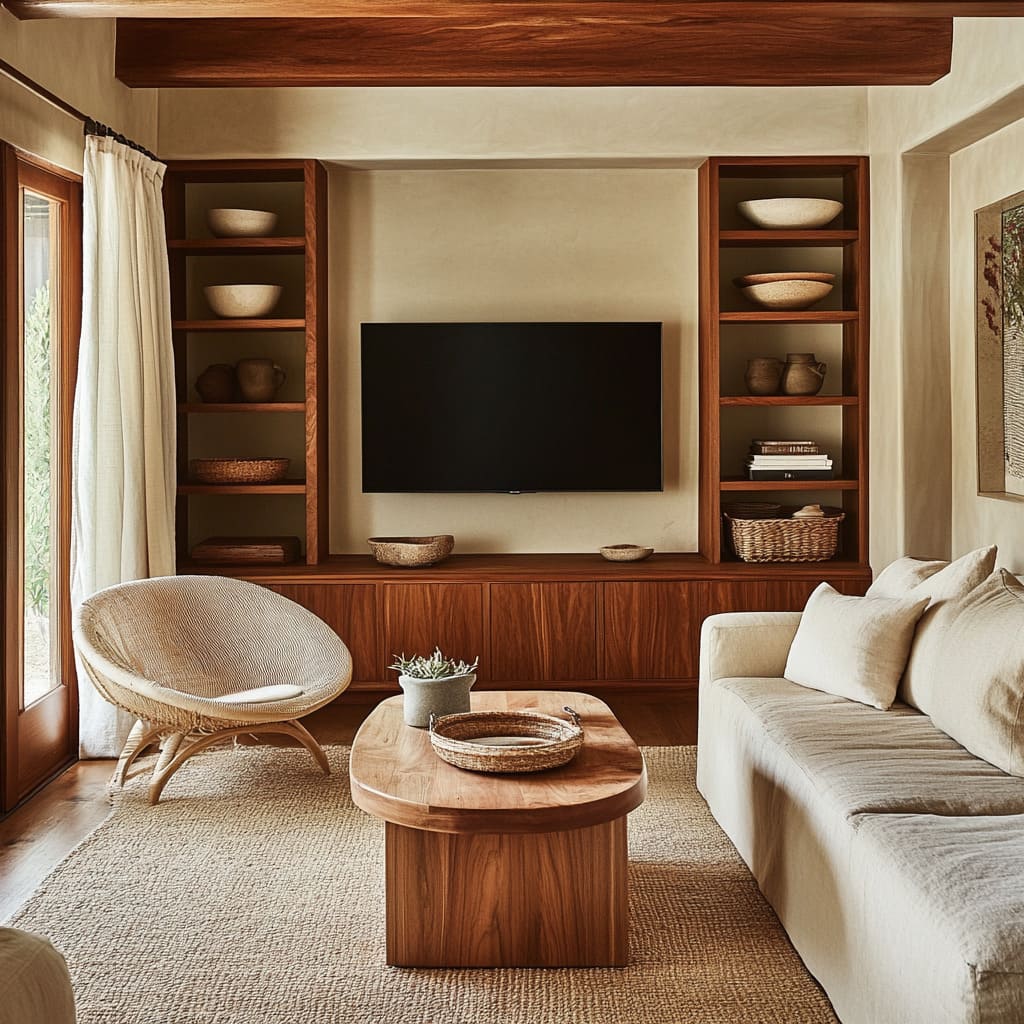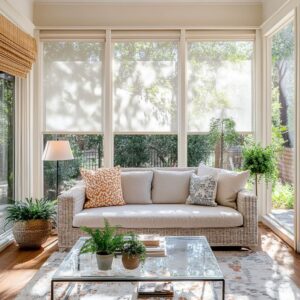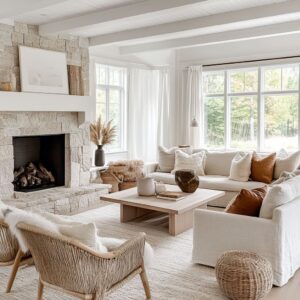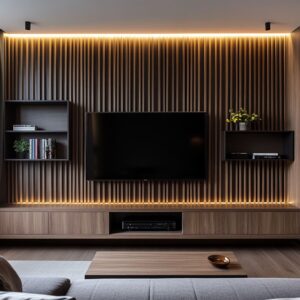The beauty of Japandi living room ideas lies in their ability to blend warmth with minimalism, creating a space that feels both structured and inviting. Rooted in the philosophies of Japanese and Scandinavian design, this style values craftsmanship, natural materials, and an effortless sense of balance.
Instead of overwhelming the room with decorative elements, Japandi relies on thoughtful details—textured fabrics, low-profile furniture, and soft lighting—to make the space feel both refined and deeply livable.
What sets Japandi interiors apart is their subtle contrast. Soft curves balance sharp lines, dark accents anchor airy palettes, and negative space ensures that no area feels cluttered.
The result is an environment that prioritizes comfort without sacrificing style. Whether through carefully placed organic elements, sculptural lighting, or a muted color scheme that flows seamlessly throughout the home, every choice contributes to a sense of harmony.
If you’re looking to create a living space that feels calm, intentional, and effortlessly stylish, Japandi is a perfect fit. By focusing on quality over quantity and embracing a connection to natural materials, you can transform any room into a welcoming retreat that supports both relaxation and function.
Textural Interplay and Why It Matters
One of the most overlooked yet powerful aspects of a Japandi style living room is how textures work together to create depth, warmth, and contrast. Unlike interiors that rely on bold colors or intricate patterns, Japandi finds its beauty in subtle variations of material finishes.
The right balance between smooth and rough, soft and firm, matte and reflective ensures the space never feels lifeless or overly uniform. When done well, this layering of textures makes a room feel welcoming and naturally composed rather than styled to perfection.
Contrasting Natural Fibers
The key to achieving a rich, well-balanced atmosphere lies in blending different natural materials that each bring a distinct tactile quality. A perfect example is how Japandi interiors often feature a jute, sisal, or woven wool rug placed over a sleek hardwood or tiled floor.
This combination does more than just define a seating area—it creates a visual and sensory contrast that adds warmth to an otherwise crisp base. The coarseness of a woven rug balances out the smoothness of wood, allowing each material to stand out without overpowering the other.
Beyond flooring, this mix of textures extends to furniture and decor. A common design move is pairing woven rattan baskets or linen-upholstered ottomans against smooth, white-painted walls.
The interplay between soft organic fibers and structured surfaces brings a quiet sense of movement, preventing the space from looking too flat or sterile. Light fixtures also play a role in this layering effect.
Instead of traditional metal or glass pendant lights, Japandi interiors often incorporate rattan or rice paper shades, which soften the glow and introduce another layer of visual interest. These elements may seem small, but they help break up uniformity, ensuring that the room feels thoughtfully arranged rather than overly curated.
Soft vs. Firm Surfaces
The balance between plush and rigid elements is another defining feature of texture layering. Japandi interiors favor sofas made from thick, textured linen or cotton blends.
These fabrics provide both a cozy appearance and a weighty presence, anchoring the seating area while maintaining a relaxed, unpretentious feel. However, if the entire space were filled with only soft elements, it could lack the visual structure needed to feel well-defined.
To counterbalance the softness of seating, Japandi designs frequently incorporate furniture pieces with strong, structured materials. A solid wood coffee table with angular edges or a polished stone-topped side table introduces a grounding effect.
The contrast between the supple cushions of a sofa and the sturdy presence of a wooden table creates a dynamic tension that keeps the composition engaging.
This same principle applies to decorative accents. A plush throw blanket draped over a firm wooden bench, or a stack of soft linen pillows arranged near a crisp-edged bookshelf, provides subtle but effective contrast.
The key is to ensure that no single texture dominates the space—each material should enhance the presence of the others, allowing for a sense of balance and quiet sophistication. By carefully curating the right mix of natural fibers, soft furnishings, and structured materials, a Japandi living space achieves an inviting depth that feels effortlessly composed.
Every element contributes to a harmonious whole, making the room feel comfortable yet refined, minimal yet full of character.
Low-Profile Furniture to Enhance Spatial Flow
One of the defining characteristics of Japandi interiors is how furniture interacts with the surrounding architecture. Seating and tables in Japandi living rooms are often lower to the ground, a design choice that extends beyond aesthetics.
While this approach draws inspiration from Japanese traditions, where floor-level seating encourages relaxation and mindfulness, it also has a transformative effect on the overall perception of space. Whether your home is compact or expansive, incorporating low-profile furniture can make the environment feel more open, grounded, and visually harmonious.
Visual Compression and Vertical Emphasis
The height of your furniture directly influences how the rest of the room is experienced. A lower sofa, for example, creates the illusion of taller walls and ceilings.
This effect is especially powerful in rooms with exposed beams or architectural detailing, as it accentuates vertical space while maintaining an inviting, human-scale proportion. Even in homes with standard ceiling heights, choosing a low-slung sectional, a futon-inspired sofa, or a coffee table with a minimalist profile can prevent the furniture from overwhelming the room.
This is particularly useful in smaller spaces, where traditional bulky seating can feel restrictive. Instead of adding weight, low-profile pieces establish a sense of openness, allowing other elements—such as textured walls, natural light, or statement decor—to take center stage.
For even greater impact, pairing low furniture with floating elements, like a wall-mounted console or a raised shelving unit, creates contrast that highlights the openness of the floor area. The interplay between grounded and elevated surfaces subtly enhances spatial flow, making the room feel thoughtfully arranged rather than crowded with heavy furniture.
Encouraging a Grounded Sensation
Another advantage of low-profile furniture is how it shifts the focus to the immediate surroundings. Sitting closer to the ground brings attention to the materials beneath—whether it’s the warmth of a handwoven jute rug, the natural grain of wooden flooring, or the soft texture of a plush wool carpet.
This change in perspective makes even subtle design details more noticeable, reinforcing the connection between the body and the environment. The psychological effect of being lower to the floor also plays a role in creating a more relaxed and immersive atmosphere.
In traditional Japanese interiors, floor seating arrangements, such as tatami mats and zabuton cushions, encourage a slower pace of living. While modern Japandi spaces may incorporate sofas for comfort, mixing in floor cushions, woven poufs, or a tea table introduces that same sense of tranquility without sacrificing functionality.
For those who prefer standard-height seating, incorporating a layered approach—such as placing a floor cushion near a coffee table or using a plush ottoman as flexible seating—adds variety without fully committing to an ultra-low arrangement. The goal is to create a space that feels anchored yet open, structured yet effortless, where furniture serves both aesthetic and emotional comfort.
By embracing low-profile furniture, Japandi interiors achieve a thoughtful balance between minimalism and warmth, allowing each element in the room to breathe while enhancing the overall sense of space.
Negative Space as a Design Tool
One of the most powerful yet subtle techniques in Japandi interior living room design is the use of negative space. While many interiors focus on filling every inch with decor, Japandi embraces the idea that emptiness is just as important as the objects themselves.
By allowing space to breathe, each piece of furniture, art, or decor has the chance to stand out with greater impact. This principle goes beyond aesthetics—it also influences how a room feels, creating a sense of calm and intentionality rather than visual overload.
Lessening Visual Overload
A common mistake in home decor is overcrowding, where too many decorative items compete for attention. Japandi interiors avoid this by carefully curating shelves, surfaces, and furniture arrangements to ensure that each piece has room to be appreciated.
Built-in shelving, for example, often features a balanced mix of filled and empty sections, making the objects feel deliberate rather than cluttered. In your own space, you can apply this idea by leaving parts of your media console, coffee table, or bookshelves unoccupied.
Instead of lining up decor in a uniform row, group items into small clusters with open space around them. This simple adjustment draws attention to textures and shapes rather than creating a visually noisy display.
Minimalist shelving arrangements often feature a single handcrafted vase, a textured bowl, or a framed print rather than an assortment of smaller trinkets. The absence of excess decor makes these selected pieces feel more significant, allowing their design and craftsmanship to take center stage.
Pacing Within a Room
Beyond shelves and surfaces, negative space also plays a crucial role in how a room feels as a whole. When furniture and decor are arranged too closely together, the eye has no place to rest, making the environment feel cramped.
Japandi interiors introduce intentional pauses in the design, using empty space to frame key elements and create a natural flow. For instance, a media console with asymmetrical shelving might leave one section open, balancing out a carefully placed sculpture or stack of books on the other side.
Similarly, a coffee table might feature just one or two decor items, ensuring that the natural grain of the wood remains visible rather than being completely covered.
These pauses help accentuate the beauty of materials, whether it’s the texture of handwoven linen curtains, a matte ceramic vase, or the grain of solid wood furniture. Negative space isn’t about removing personality—it’s about highlighting it in a way that feels refined and effortless.
By embracing this approach, your living room will feel lighter, more balanced, and inherently calming, proving that sometimes, less truly is more.
Consistent but Layered Color Palettes
One of the defining traits of a Japandi interior living room is the careful selection of colors that maintain a sense of consistency while allowing for subtle variation. Instead of relying on a wide spectrum of bold hues, this style leans toward a refined palette of whites, beiges, soft browns, and muted grays.
At first glance, these colors might seem uniform, but a closer look reveals intentional shifts in tone that create depth and prevent the space from feeling flat or monotonous. The key is in the layering—using slightly different shades within the same color family to highlight the individuality of each surface, textile, or furniture piece.
This ensures that while everything blends harmoniously, no single element disappears into the background.
Subtle Variation in Tones
In well-designed Japandi spaces, you’ll often notice that the walls, furniture, and textiles all share a similar color language, yet each component is deliberately a shade lighter or darker than the next. For example, a soft beige sofa might sit against a slightly lighter cream-colored wall, while a woven area rug in warm taupe adds another layer of distinction.
The result is a room that feels unified yet never dull.
This effect can be easily achieved at home by selecting a base color and building around it with complementary neutrals that are one or two steps lighter or darker. If your walls are painted in a light taupe, consider a couch in a deeper mushroom tone and a wool throw in an even paler beige.
These shifts in tone create a sense of movement without breaking the overall cohesion. It’s also worth paying attention to finishes.
Matte paint on walls contrasts beautifully with linen upholstery or the subtle sheen of a silk-blend curtain. Even when using neutral colors, a mix of textures prevents the space from feeling static.
Balancing Warm and Cool Undertones
A common mistake in monochromatic or neutral-toned interiors is leaning too far into either warm or cool hues, making the space feel either overly rustic or too stark. Japandi interiors excel in balancing the two, allowing the room to feel calm yet structured.
- Warm beige or natural wood tones often pair well with cool gray accents to create an interplay of temperature that keeps the palette from feeling one-dimensional. For example, if you have oak or walnut furniture, introduce charcoal-toned ceramics or slate-colored cushions to provide contrast.
- If your walls are a cooler white or gray, consider softening the effect with a tan jute rug, a driftwood-style coffee table, or rattan light fixtures. This not only adds warmth but also brings in an organic element that makes the space feel more inviting.
By using this balance of temperature and subtle layering of tones, Japandi interiors achieve a refined yet welcoming atmosphere where every color choice is intentional. The room never feels overwhelming, yet it holds enough depth to remain visually interesting.
Thoughtful Inclusion of Dark Accents
A well-designed Japandi living room decor relies on balance, and one of the most effective ways to achieve this is through carefully placed dark accents. While the overall aesthetic of Japandi leans toward soft neutrals, light woods, and airy textures, introducing touches of black or deep brown ensures the space doesn’t feel washed out.
These darker elements act as subtle yet powerful contrasts, adding depth and refinement without overpowering the room’s natural warmth. Dark tones in Japandi interiors are rarely used in excess.
Instead, they appear in small, intentional ways—perhaps in the form of a black-framed window, a dark-stained wood coffee table, or a matte ceramic vase on an open shelf. These details serve as focal points that anchor the design, giving structure to an otherwise muted palette.
Visual Anchoring
Dark accents act as a grounding force in a space dominated by light woods, soft textiles, and organic textures. Without them, an all-neutral Japandi interior can sometimes feel too delicate or visually unstructured.
Introducing a black pendant lamp, slim black metal legs on furniture, or a dark-framed artwork creates just the right amount of contrast, helping define different areas of the room.
If your living room lacks a natural focal point, a well-placed dark element can subtly create one. A small black side table placed next to a linen sofa, or a dark ceramic bowl on a light wood coffee table, draws attention without disrupting the minimalist flow.
Even something as simple as a black picture frame leaning against a wall adds just enough definition to keep the design from feeling too airy. For a more integrated approach, built-in shelving or a media console with deep wood tones or charcoal slats provides contrast while maintaining Japandi’s signature clean lines.
These elements should never overwhelm the space but instead serve as visual anchors that make lighter materials stand out even more.
Balancing With Natural Light
The success of dark accents in Japandi interiors depends on how they interact with light. Since this style prioritizes soft, diffused daylight and warm-toned artificial lighting, darker details should be positioned where they complement—not overpower—the room’s natural glow.
For example, black-framed windows or sliding glass doors offer a crisp outline that contrasts beautifully against white or off-white walls. This not only enhances the view outside but also frames the space in a way that feels modern yet timeless.
Similarly, a dark wood beam or floating shelf adds structure while allowing surrounding materials to remain light and open. Even in the evening, the right lighting ensures that dark accents feel deliberate rather than heavy.
A paper lantern pendant light or a floor lamp with a woven shade can soften the impact of a dark wood coffee table or shelving unit, keeping the atmosphere warm and inviting. By using dark details sparingly but strategically, Japandi interiors achieve a harmonious balance between light and shadow, creating depth, contrast, and a sense of quiet sophistication.
Organic Shapes Paired With Straight Lines
A defining feature of Japandi living room design is the way it balances crisp, linear architecture with soft, organic curves. This contrast is what makes the style feel both structured and welcoming, modern yet warm.
Too many straight lines can make a space feel rigid, while an excess of rounded forms can lack structure. The right mix of both creates a dynamic tension that keeps the eye engaged and the space feeling naturally composed.
Tension and Harmony
Rooms dominated by straight lines—whether in shelving, console designs, or architectural elements like ceiling beams—can sometimes feel overly structured. A carefully placed curved object breaks up this formality and softens the overall look.
A round coffee table, an arched mirror, or a sculptural lounge chair with a curved backrest can introduce just the right amount of contrast. These elements prevent the space from feeling too rigid and instead bring in a sense of quiet movement.
The best way to determine how much curve is needed is by looking at your existing layout. If the architecture is boxy, with rectangular doorways and squared-off furniture, adding rounded shapes in seating or lighting will make the room feel more balanced.
On the other hand, if your home already has arched windows, vaulted ceilings, or curved doorways, incorporating sharper, more angular furniture—like a rectilinear coffee table or a clean-lined sofa—will maintain a structured look while still feeling warm and inviting. This interplay is what makes Japandi interiors feel effortless.
A mix of curved and straight elements creates a room that feels complete, without a single piece looking out of place.
Functional Sculptural Pieces
Beyond their visual impact, curved and angular forms in Japandi interiors serve both aesthetic and practical functions. Many of the most eye-catching elements in this style do more than just add contrast—they act as sculptural pieces that also serve a purpose.
For example, a rattan pendant light with a rounded, organic silhouette doesn’t just soften the angularity of a room—it also diffuses light in a way that creates warmth and texture. A sculptural wooden chair with a curved frame offers both comfort and an artistic statement, making it as much a design feature as it is a seating option.
When selecting furniture and decor, look for items that feel subtly artistic without being over-the-top. A coffee table with softly rounded edges, a paper lantern with an asymmetrical form, or a low-profile armchair with smooth, flowing lines are all great examples of how function and form can work together.
These pieces introduce variety without overwhelming the clean, calming aesthetic of Japandi interiors. By thoughtfully combining straight-edged elements with organic shapes, a Japandi living room achieves a perfect balance between order and fluidity, making the space feel structured yet relaxed, minimal yet full of quiet character.
Symmetry vs. Asymmetry for Interest
A well-balanced Japandi living room design often plays with the contrast between structured symmetry and relaxed asymmetry. While traditional layouts tend to rely on evenly arranged furniture and decor, Japandi interiors introduce small variations that prevent the space from feeling overly formal or predictable.
This thoughtful approach ensures the room remains visually engaging while maintaining its sense of calm.
Symmetrical Architecture, Asymmetrical Styling
Many Japandi spaces feature symmetrical architectural elements, such as built-in shelves flanking a fireplace, evenly spaced wall sconces, or a pair of matching armchairs. These elements create a sense of stability and order, reinforcing the minimalist foundation of the design.
However, rather than adhering to strict uniformity, the styling within these structures often leans asymmetrical to create a more inviting atmosphere. For instance, while built-in shelving may appear evenly balanced on either side of a TV unit or fireplace, the objects displayed within them introduce subtle variations.
One shelf may hold a larger ceramic vase, while the other features a smaller stack of books with a trailing plant. This method keeps the symmetry in place while ensuring the space feels dynamic rather than rigid.
This approach can also be applied to furniture placement. Two identical chairs may sit across from a coffee table, but the surrounding accessories—like a sculptural lamp on one side and a woven basket on the other—break up the uniformity just enough to add depth.
Subtle Off-Center Choices
Asymmetry doesn’t have to be bold to be effective. Small, off-center design decisions can make a space feel more natural while keeping it visually structured.
Console tables or TV units often demonstrate this principle beautifully. Instead of a perfectly symmetrical arrangement, a console table might have a tall vase or lamp on one end and a more open space on the other.
This creates an effortless sense of flow without looking haphazard. The same idea applies to plants.
Rather than placing a matching set on either side of a sofa, a single large indoor tree or potted plant placed on one end can provide a striking counterbalance to more structured furniture elements. By blending symmetry with subtle asymmetrical touches, Japandi interiors strike the perfect balance between order and informality.
The result is a space that feels structured yet relaxed, intentional yet effortless—a combination that makes this design style both inviting and timeless.
Softly Diffused Lighting for a Tranquil Mood
Lighting plays a vital role in setting the atmosphere of a Japandi living room design, with a strong emphasis on soft, layered illumination. Instead of harsh overhead lights or overly bright fixtures, Japandi interiors rely on filtered, diffused light that creates warmth and depth.
This approach ensures that every part of the room feels calm, inviting, and naturally balanced. Whether through paper lantern pendants, woven rattan lampshades, or sheer curtains that gently filter daylight, the goal is to soften light rather than flood the space with it.
These subtle variations in brightness help shape the room’s ambiance, making it feel comfortable at any time of day.
Layered Lighting Schemes
One of the most effective ways to achieve this soft glow is through multiple light sources at different heights rather than relying on a single overhead fixture. Many Japandi spaces incorporate a main pendant or lantern for general lighting, complemented by smaller floor lamps, wall sconces, or table lamps that add dimension.
This layered effect allows for flexibility, making it easy to adjust the atmosphere depending on the time of day or the mood you want to create. In the evening, a combination of a low-hanging rattan pendant, a softly glowing table lamp, and a subtle wall sconce can transform a space, keeping it illuminated without feeling stark.
For a more grounded and intimate feel, adding a lamp at a lower level—such as beside a sofa or on a console table—helps direct light toward seating areas or shelves, creating natural focal points that enhance the room’s flow.
Paper and Rattan for Shadows
Another distinctive element in Japandi lighting design is the use of woven or paper shades, which do more than just diffuse light—they create an interplay of shadows and highlights that adds a delicate sense of movement to the space. The subtle shadows cast by a rattan pendant light or a sculptural rice-paper lantern bring a quiet, organic rhythm that makes the room feel more dynamic, even in its stillness.
This effect is particularly useful in neutral spaces where color contrast is minimal. Instead of relying on bold hues for visual interest, the shadows created by woven lighting fixtures introduce soft patterns on walls and ceilings, making the environment feel layered without disrupting the clean aesthetic.
If you’re looking for a way to introduce a focal point without using bold colors, a pendant light with a shadow-casting effect can be the perfect addition. Whether placed over a dining table, seating area, or reading nook, it adds depth while maintaining the effortless simplicity that defines Japandi interiors.
By carefully selecting lighting elements that work with natural light during the day and enhance warmth in the evening, a Japandi space achieves a balanced, inviting glow that feels both functional and atmospheric.
Conclusion
A well-designed Japandi living space is more than a collection of neutral tones and minimalist furniture—it is a study in balance, subtlety, and craftsmanship. Every detail, from the interplay of textures to the careful placement of sculptural accents, contributes to an atmosphere that feels intentional without being rigid.
What makes Japandi interiors stand out is how they embrace contrast in a way that feels effortless. Soft linen cushions rest against structured wooden frames, low-profile sofas emphasize the height of surrounding architecture, and dark accents ground the otherwise airy palette.
Even negative space plays a role, ensuring that each element has room to breathe while still feeling connected to the whole.
The beauty of Japandi design lies in its ability to make simplicity feel rich with depth. A single well-placed vase, a woven pendant light casting soft shadows, or a textured rug anchoring a seating area—these elements do more than decorate a space.
They shape the way a room is experienced, making it both visually calming and functionally inviting. By incorporating these thoughtful details, a living room can become a place that supports daily life with quiet elegance—never empty, never cluttered, but always purposeful.
